Paul van Yperen's Blog, page 115
August 14, 2022
Margaret Leighton
Tall, reedy, thin-browed, light-haired Margaret Leighton (1922-1976) was a British award-winning theatre and film actress. She appeared with her future husband Michael Wilding in the Hitchcock film Under Capricorn (1949). She won two Tony Awards for Broadway performances as Best Actress (Dramatic): in 1957 for 'Separate Tables' and in 1962 for Tennessee Williams' 'The Night of the Iguana'. Leighton received an Oscar nomination and a BAFTA award for her role in The Go-Between (Joseph Losey, 1971). She also won an Emmy Award for a 1970 television version of 'Hamlet'.
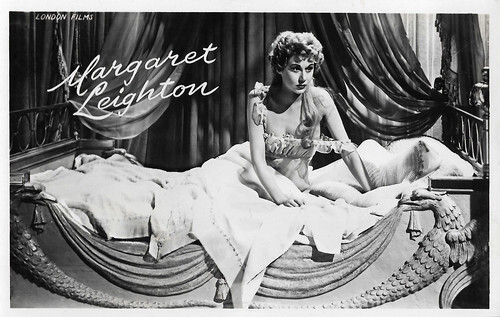
Vintage card. Photo: London Films. Margaret Leighton in The Elusive Pimpernel (Michael Powell, Emeric Pressburger, 1949).
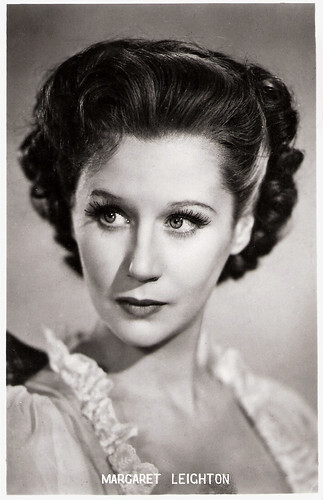
British Real Photograph postcard, no. F.S. 63. Caption: Lovely Margaret Leighton won universal praise for her part as Flora Macdonald in Bonnie Prince Charlie. She is now co-starring with David Niven in The Elusive Pimpernel, an Archer's production for London Films.
Stunning portrayals of neurotic, brittle matrons
Margaret Leighton was born in Barnt Green, Worchestershire, England, in 1922, the daughter of a businessman. Expressing an early desire to act, she quit school at age 15 and auditioned and joined Sir Barry Jackson's Birmingham Repertory Theatre.
Becoming one of his star students, he hired her as a stage manager and offered her the small role of Dorothy in the stage play 'Laugh with Me' (1938). Thereby, the play marked her professional debut on stage. The play was immediately taken to the BBC-TV, Laugh with Me (Herbert C. Prentice, 1938). During these productive repertory years, she involved herself in the classical plays by Chekov, Shakespeare, and Shaw.
In 1944, Margaret made her London debut for the Old Vic Company playing the daughter of the troll king in 'Peer Gynt'. Joining the company under the auspices of Sir Laurence Olivier and Sir Ralph Richardson , she earned distinction as a classical stage actress. In 1946, she made her Broadway debut as the Queen in 'Henry IV', starring Laurence Olivier and Ralph Richardson during a visit of the Old Vic to the U.S. The company performed a total of five plays from its repertoire before returning to London.
The opulent actress with the strikingly odd, yet fascinating facial features stole more than a few plays and films away from the stars with her stunning portrayals of neurotic, brittle matrons. Her unique brand of sophisticated eccentricity went on to captivate both Broadway and London audiences with her many theatre offerings, particularly her portrayals of Celia Coplestone in 'The Cocktail Party (1950) and Orinthia in a revival of 'The Apple Cart' (1953). Her New York performance as Mrs. Shankland in Terence Rattigan's drama 'Separate Tables' (1956) earned her a Tony Award.
She returned to Broadway to play Beatrice in William Shakespeare 's 'Much Ado About Nothing' in 1959, before returning in 1962 as Hannah in 'The Night of the Iguana' and earning her second Best Actress Tony trophy. She would continue to return to Broadway throughout the 1960s with the plays 'Tchin-Tchin', 'The Chinese Prime Minister', 'Slapstick Tragedy' and the heralded production of 'The Little Foxes (1967)', first playing Birdie before taking over the role of Regina.
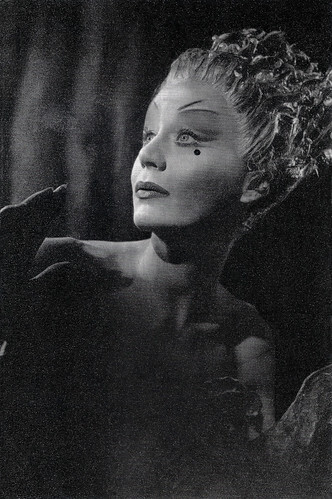
British postcard in the Shakespeare Memorial Theatre series number 20. Photo: Angus McBean. Margaret Leighton as Ariel in 'A Midsummer Night's Dream', Stratford-upon-Avon, 1952.
Alternating between films in London and Hollywood
During the 1950s and 1960s, Margaret Leighton would alternate between British and U.S. filming. She made her British debut as Catherine Winslow in Terrence Rattigan's The Winslow Boy (Anthony Asquith, 1948) starring Robert Donat . Then she co-starred opposite David Niven in the period biopic Bonnie Prince Charlie (Anthony Kimmins, 1948).
Hitchcock used her next in one of his lesser-known romantic crime films Under Capricorn (Alfred Hitchcock, 1949) before entangling herself in a romantic triangle with Celia Johnson and Noël Coward in The Astonished Heart (1950), which was both written and directed by Coward.
In the crime film Calling Bulldog Drummond (Victor Saville, 1951), Margaret plays a Scotland Yard sergeant who pulls the master sleuth (Walter Pidgeon) out of retirement to infiltrate a vicious gang together, while in the mystery crime drama, Home at Seven (Ralph Richardson, 1952), the touching drama The Holly and the Ivy (George More O'Ferrall, 1952) and the saucy comedy The Passionate Stranger (Muriel Box, 1957), she reunited with her Old Vic theatre mentor Sir Ralph Richardson .
Richardson was her frequent co-star on both stage and screen. She had played Roxane to his Cyrano in the 1946 London stage revival of 'Cyrano de Bergerac', one of Richardson's greatest stage successes.
Margaret married (1947) and divorced (1955) noted publisher Max Reinhardt (of Reinhardt & Evans), known for his collection of letters and photographs from playwright and novelist George Bernard Shaw. Her second husband would be actor Laurence Harvey who starred in the British crime thriller The Good Die Young (Lewis Gilbert, 1954) in which Margaret made a co-starring appearance as his abused wife. They would marry in 1957.
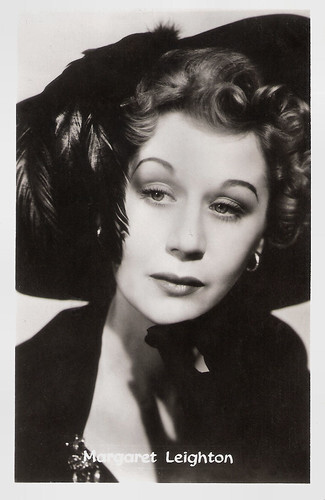
Vintage card.
Diagnosed with Multiple Sclerosis
Margaret Leighton earned her first top cinematic billing as Helen Teckman in The Teckman Mystery (Wendy Toye, 1954) and reunited with David Niven in the military film Carrington V.C. (Anthony Asquith, 1954). Playing a Southern aristocrat in the U.S. filming of William Faulkner's The Sound and the Fury (Martin Ritt, 1959) starring Yul Brynner , she followed that in the 1960s with a co-starring part opposite Peter Sellers in the comedy Waltz of the Toreadors (John Guillermin, 1962) and an all-star American cast headed by Henry Fonda in the potent political drama The Best Man (Franklin J. Schaffner, 1964).
The black comedy The Loved One (Tony Richardson, 1965) and the dramatic 7 Women (John Ford, 1966), playing one of several ladies in peril at a Chinese mission, followed. Appearing in TV-movie versions of literary classics including 'Arms and the Man', 'As You LIke It' and 'The Confidential Clerk', Margaret began to make guest appearances on TV programs such as 'Suspicion,' 'Alfred Hitchcock Presents, 'The Alfred Hitchcock Hour', 'Playhouse 90', 'Ben Casey', 'Burke's Law', 'The F.B.I.', 'The Girl from U.N.C.L.E.' and 'Judd for the Defense', in addition to a recurring role on 'Dr. Kildare'.
Divorced from Laurence Harvey in 1961, Margaret's third and final marriage to actor Michael Wilding in 1964 was an enduring matchup. The couple went on to co-star in the period piece Lady Caroline Lamb (Robert Bolt, 1972) starring Sarah Miles. Other notable screen credits around that time include The Madwoman of Chaillot (Bryan Forbes, 1969) and the TV movie Great Expectations (Joseph Hardy, 1974) as Miss Havisham. Margaret would receive her only Oscar nomination for her support role in The Go-Between (Joseph Losey, 1971) starring Julie Christie and Alan Bates as Christie's manipulative, class-conscious mother.
In 1971, Margaret was diagnosed with multiple sclerosis but didn't let it slow her down for quite some time. She continued to perform in such films as Zee and Co. (Brian G. Hutton, 1972) with Elizabeth Taylor , Bequest to the Nation (James Cellan Jones, 1973), and the TV horror offering Frankenstein: The True Story (Jack Smight, 1973).
By 1975 when she was no longer capable of walking, she continued to act giving an over-the-top comic performance in Trial by Combat (Kevin Connor, 1976). Her final TV performance was in the first season of Space: 1999 where she played Queen Arra in the episode "Collision Course. She was awarded the CBE (Commander of the Order of the British Empire) in the 1974 Queen's Birthday Honours List for her services to drama. She breathed her last in 1976 in Chichester hospital in Chichester, Sussex, at the age of 56. Margaret Leighton had no children in any of her marriages.
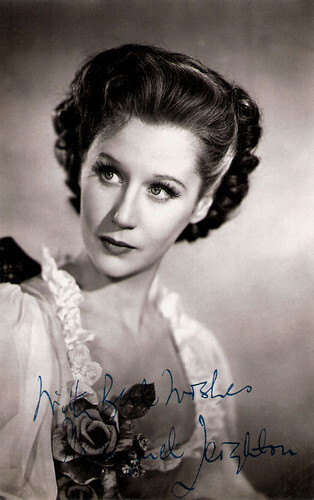
British autograph card.
Sources: (IMDb), Wikipedia (Dutch and English), and .

Vintage card. Photo: London Films. Margaret Leighton in The Elusive Pimpernel (Michael Powell, Emeric Pressburger, 1949).

British Real Photograph postcard, no. F.S. 63. Caption: Lovely Margaret Leighton won universal praise for her part as Flora Macdonald in Bonnie Prince Charlie. She is now co-starring with David Niven in The Elusive Pimpernel, an Archer's production for London Films.
Stunning portrayals of neurotic, brittle matrons
Margaret Leighton was born in Barnt Green, Worchestershire, England, in 1922, the daughter of a businessman. Expressing an early desire to act, she quit school at age 15 and auditioned and joined Sir Barry Jackson's Birmingham Repertory Theatre.
Becoming one of his star students, he hired her as a stage manager and offered her the small role of Dorothy in the stage play 'Laugh with Me' (1938). Thereby, the play marked her professional debut on stage. The play was immediately taken to the BBC-TV, Laugh with Me (Herbert C. Prentice, 1938). During these productive repertory years, she involved herself in the classical plays by Chekov, Shakespeare, and Shaw.
In 1944, Margaret made her London debut for the Old Vic Company playing the daughter of the troll king in 'Peer Gynt'. Joining the company under the auspices of Sir Laurence Olivier and Sir Ralph Richardson , she earned distinction as a classical stage actress. In 1946, she made her Broadway debut as the Queen in 'Henry IV', starring Laurence Olivier and Ralph Richardson during a visit of the Old Vic to the U.S. The company performed a total of five plays from its repertoire before returning to London.
The opulent actress with the strikingly odd, yet fascinating facial features stole more than a few plays and films away from the stars with her stunning portrayals of neurotic, brittle matrons. Her unique brand of sophisticated eccentricity went on to captivate both Broadway and London audiences with her many theatre offerings, particularly her portrayals of Celia Coplestone in 'The Cocktail Party (1950) and Orinthia in a revival of 'The Apple Cart' (1953). Her New York performance as Mrs. Shankland in Terence Rattigan's drama 'Separate Tables' (1956) earned her a Tony Award.
She returned to Broadway to play Beatrice in William Shakespeare 's 'Much Ado About Nothing' in 1959, before returning in 1962 as Hannah in 'The Night of the Iguana' and earning her second Best Actress Tony trophy. She would continue to return to Broadway throughout the 1960s with the plays 'Tchin-Tchin', 'The Chinese Prime Minister', 'Slapstick Tragedy' and the heralded production of 'The Little Foxes (1967)', first playing Birdie before taking over the role of Regina.

British postcard in the Shakespeare Memorial Theatre series number 20. Photo: Angus McBean. Margaret Leighton as Ariel in 'A Midsummer Night's Dream', Stratford-upon-Avon, 1952.
Alternating between films in London and Hollywood
During the 1950s and 1960s, Margaret Leighton would alternate between British and U.S. filming. She made her British debut as Catherine Winslow in Terrence Rattigan's The Winslow Boy (Anthony Asquith, 1948) starring Robert Donat . Then she co-starred opposite David Niven in the period biopic Bonnie Prince Charlie (Anthony Kimmins, 1948).
Hitchcock used her next in one of his lesser-known romantic crime films Under Capricorn (Alfred Hitchcock, 1949) before entangling herself in a romantic triangle with Celia Johnson and Noël Coward in The Astonished Heart (1950), which was both written and directed by Coward.
In the crime film Calling Bulldog Drummond (Victor Saville, 1951), Margaret plays a Scotland Yard sergeant who pulls the master sleuth (Walter Pidgeon) out of retirement to infiltrate a vicious gang together, while in the mystery crime drama, Home at Seven (Ralph Richardson, 1952), the touching drama The Holly and the Ivy (George More O'Ferrall, 1952) and the saucy comedy The Passionate Stranger (Muriel Box, 1957), she reunited with her Old Vic theatre mentor Sir Ralph Richardson .
Richardson was her frequent co-star on both stage and screen. She had played Roxane to his Cyrano in the 1946 London stage revival of 'Cyrano de Bergerac', one of Richardson's greatest stage successes.
Margaret married (1947) and divorced (1955) noted publisher Max Reinhardt (of Reinhardt & Evans), known for his collection of letters and photographs from playwright and novelist George Bernard Shaw. Her second husband would be actor Laurence Harvey who starred in the British crime thriller The Good Die Young (Lewis Gilbert, 1954) in which Margaret made a co-starring appearance as his abused wife. They would marry in 1957.

Vintage card.
Diagnosed with Multiple Sclerosis
Margaret Leighton earned her first top cinematic billing as Helen Teckman in The Teckman Mystery (Wendy Toye, 1954) and reunited with David Niven in the military film Carrington V.C. (Anthony Asquith, 1954). Playing a Southern aristocrat in the U.S. filming of William Faulkner's The Sound and the Fury (Martin Ritt, 1959) starring Yul Brynner , she followed that in the 1960s with a co-starring part opposite Peter Sellers in the comedy Waltz of the Toreadors (John Guillermin, 1962) and an all-star American cast headed by Henry Fonda in the potent political drama The Best Man (Franklin J. Schaffner, 1964).
The black comedy The Loved One (Tony Richardson, 1965) and the dramatic 7 Women (John Ford, 1966), playing one of several ladies in peril at a Chinese mission, followed. Appearing in TV-movie versions of literary classics including 'Arms and the Man', 'As You LIke It' and 'The Confidential Clerk', Margaret began to make guest appearances on TV programs such as 'Suspicion,' 'Alfred Hitchcock Presents, 'The Alfred Hitchcock Hour', 'Playhouse 90', 'Ben Casey', 'Burke's Law', 'The F.B.I.', 'The Girl from U.N.C.L.E.' and 'Judd for the Defense', in addition to a recurring role on 'Dr. Kildare'.
Divorced from Laurence Harvey in 1961, Margaret's third and final marriage to actor Michael Wilding in 1964 was an enduring matchup. The couple went on to co-star in the period piece Lady Caroline Lamb (Robert Bolt, 1972) starring Sarah Miles. Other notable screen credits around that time include The Madwoman of Chaillot (Bryan Forbes, 1969) and the TV movie Great Expectations (Joseph Hardy, 1974) as Miss Havisham. Margaret would receive her only Oscar nomination for her support role in The Go-Between (Joseph Losey, 1971) starring Julie Christie and Alan Bates as Christie's manipulative, class-conscious mother.
In 1971, Margaret was diagnosed with multiple sclerosis but didn't let it slow her down for quite some time. She continued to perform in such films as Zee and Co. (Brian G. Hutton, 1972) with Elizabeth Taylor , Bequest to the Nation (James Cellan Jones, 1973), and the TV horror offering Frankenstein: The True Story (Jack Smight, 1973).
By 1975 when she was no longer capable of walking, she continued to act giving an over-the-top comic performance in Trial by Combat (Kevin Connor, 1976). Her final TV performance was in the first season of Space: 1999 where she played Queen Arra in the episode "Collision Course. She was awarded the CBE (Commander of the Order of the British Empire) in the 1974 Queen's Birthday Honours List for her services to drama. She breathed her last in 1976 in Chichester hospital in Chichester, Sussex, at the age of 56. Margaret Leighton had no children in any of her marriages.

British autograph card.
Sources: (IMDb), Wikipedia (Dutch and English), and .
Published on August 14, 2022 22:00
August 13, 2022
Photo by Walery
Stanisław Julian Ignacy Ostroróg also known as Walery (1863-1929) was a Polish photographer active in London and Paris between 1890 and 1929. After inheriting his father's name and photographic studio in London, he continued with portraiture for about a decade until the turn of the century when he moved definitively to Paris. There he achieved celebrity as an innovator and accomplished photographer of cabaret stars and of the female form.
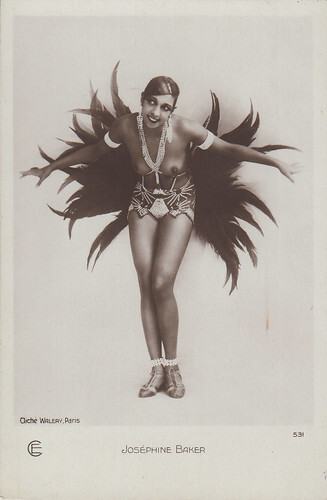
French postcard by Cinémagazine-Edition (CE), no. 531. Photo: Walery, Paris. Josephine Baker in La revue des revues/Parisian Pleasures (Joe Francis, 1927). Collection: Marlene Pilaete.
Josephine Baker (1906-1975) was well-known as a singer and dancer. In 1925 she became an instant success in Paris, because of her erotic dance. She also performed in a handful of silent and early sound films, La Sirene des Tropiques (1927), Zouzou (1934) and La princesse TamTam (1935).
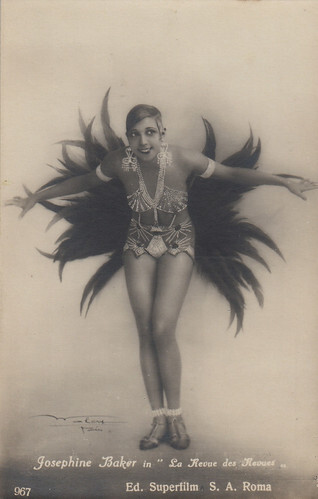
Italian postcard by Ed. A. Traldi, Milano, no. 967. Photo: Walery. Collection: Marlene Pilaete. You will notice a difference between this postcard and the previous one: a bra covering Josephine Baker’s breasts. Italian editor Traldi chose to censor Josephine’s nakedness and print a retouched photo, possibly in a bout of prudery?
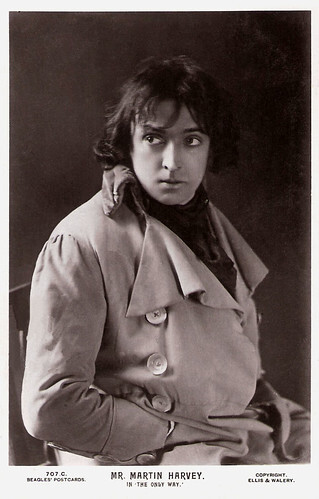
British postcard by Beagles Postcards, no. 707 C. Photo: Ellis & Walery. Publicity still for the stage play 'The Only Way'.
British Actor-manager Sir John Martin Harvey (1863-1944) was one of the last great romantic actors in the English theatre. His most famous play was 'The Only Way' (1899), an adaptation of Charles Dickens' 'A Tale of Two Cities'. 25 years later, he also featured in the film version, as well as in a few other silent and sound films.
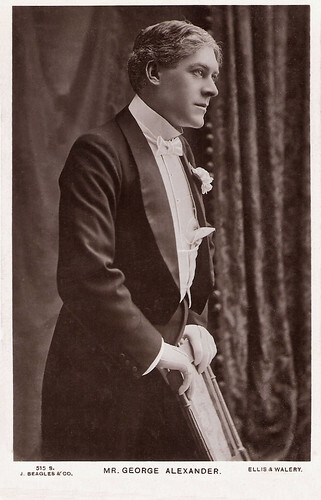
British postcard by J. Beagles & Co, London, no. 515 S. Photo: Ellis & Walery.
Sir George Alexander (1858-1918) was an English actor and theatre manager. One of his most famous stage roles was in 'The Prisoner of Zenda' by Anthony Hope, which premiered in 1896.
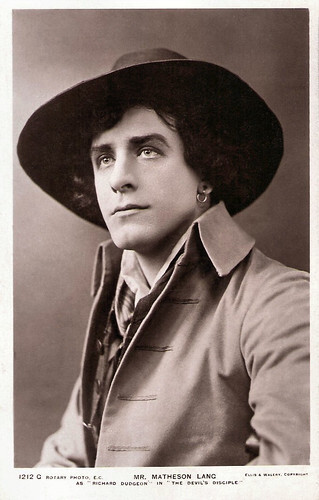
British postcard by Rotary, no. 1212C. Photo: Ellis & Walery. Publicity still for the play 'The Devil's Disciple' (1907).
Tall and good-looking Matheson Lang (1879-1948) was a Canadian-born stage and film actor and playwright in the early 20th century. He is best known for his Shakespearean roles in British productions of 'Hamlet', 'Macbeth', and 'Romeo and Juliet' and for his role as Mr. Wu. He was one of the first major stars of the British theatre who acted in a silent film and during the 1920s, he became a popular film star in Great Britain.
A Regent Street studio
Stanisław Julian Ignacy Ostroróg was born in 1863 in London into a family of political emigrants of Polish noble descent. He was the eldest child of Count Stanisław Julian Ostroróg, a British subject and his Polish wife, Teodozja Waleria, née Gwozdecka. His father was born in the Russian Partition of what had once been the Polish–Lithuanian Commonwealth, not long after the November uprising of 1830 which led to severe repression of the insurgents, of which the family had been part.
After the war, his father settled in London and was granted citizenship in 1862 and married. After the birth of Stanisław junior, the family headed to Marseille to set up a photographic studio. In 1866 the family were back in Warsaw, but the following year after the death of the second son, they left for Paris in time for the birth of the third son, Leon. There Ostroróg senior resumed his successful photographic career under the brand name "Walery" (without an accent), in honour of his wife's first name.
In 1878 his creditor's financial difficulties forced him to give up trading and the family moved back to London in 1880. He opened a Regent Street studio where Stanisław junior was eventually to join his father.
Although born in England, Stanisław junior was sent to Poland, presumably to relatives, to learn Polish while his parents returned to France where his father developed his photographic career. In 1871, during the Paris Commune, he was sent there for his schooling. During that period, his parents divorced and his father remarried. At around 18 years of age and following family tradition, he obtained a commission in the army, only this time in the Royal Artillery at Woolwich. This was short-lived as he evinced an interest in his father's business and resigned from the army.
At his father's insistence, he went to Paris for two years to study the techniques of photography, including portraiture. He returned to England to rejoin his father, who by then was enjoying great success and found he was not needed in the studio and so accepted a proposal to go to Mexico for a year helping in the construction of a railway and opening up a colony. He spent the next few years travelling with a camera and survey instruments in Africa, to places like Natal and Zululand. The sudden death of his father from an aneurism brought him back to London, where he took over the management of his father's studio in 1890.
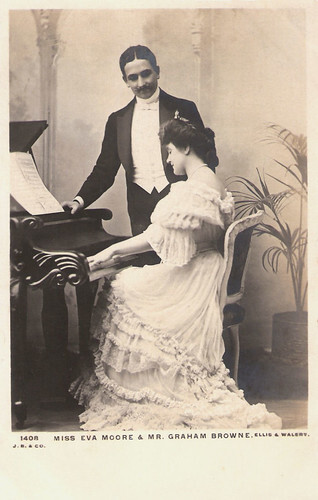
British postcard by J. Beagles & Co., London, no. 1408. Photo: Ellis & Walery.
English actress Eva Moore (1870–1955) had a career on stage and in the film which spanned six decades. She was active in the women's suffrage movement, and from 1920 on she appeared in over two dozen films.
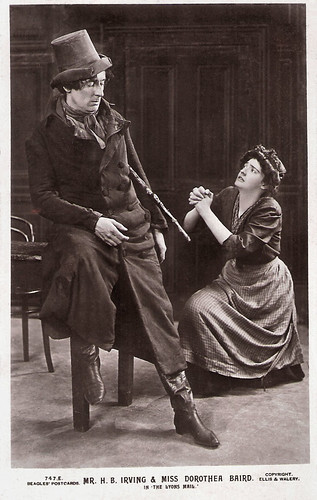
British postcard by J. Beagles & Co., London, no. 747 E. Photo: Ellis and Walery. Publicity still for the stage production of The Lyons Mail (1905).
The play 'The Courier of Lyons' (1854) by Charles Reade was a very popular stage work of the Victorian era. A respectable French gentleman is mistaken for his doppelganger, a notorious highwayman. The double roles of the villain Dubosc and the hero Lesurques had been previously played by Henry Irving and, after his death, were taken on by his son, H.B. Irving . His stage version of The Lyons Mail was in 1916 turned into a British silent film with Irving again as Lesurques / Dubosc, but now without his wife Dorothea Baird in the cast. The film version was directed by Fred Paul and produced by the Ideal Film Company, one of the leading British silent film studios.
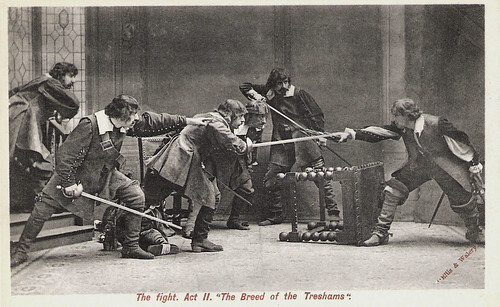
British postcard. Photo: Ellis & Walery. Publicity photo for a stage production of 'The Breed of the Treshams'.
John Martin Harvey played Reresby 'the Rat' in many stage productions between 19003 and 1934 as well as in the film The Breed of the Treshams (Kenelm Foss, 1920) with Mary Odette .
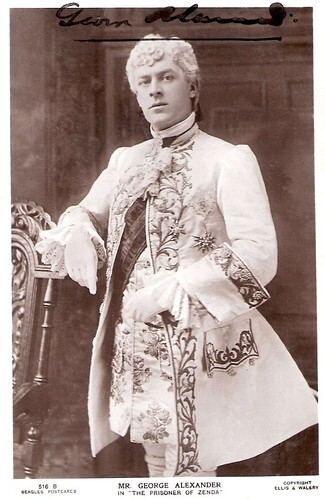
British postcard by J. Beagles & Co., Ltd., Printers & Publishers, no. 516 B. Photo: Ellis & Walery. Publicity photo for a stage production of 'The Prisoner of Zenda'.
Sir George Alexander (1858-1918) was an English actor and theatre manager. One of his most famous stage roles was in 'The Prisoner of Zenda' by Anthony Hope, which premiered in 1896.
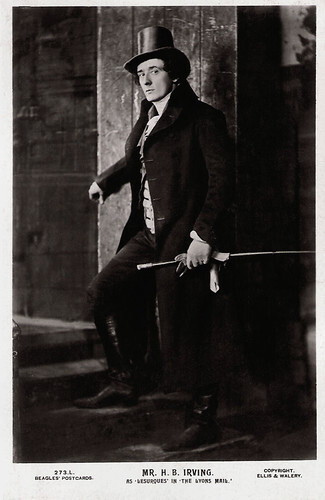
British postcard by J. Beagles & Co., no. 273 L. Photo: Ellis & Walery. Photo: publicity still for the stage production of 'The Lyons Mail' (1905) with Irving as Lesurques.
H.B. Irving (1870-1919) was a British stage actor and actor-manager. He was the eldest son of Sir Henry Irving. Despite his many roles on stage and in the silent cinema, Irving is now best known for 'A Book of Remarkable Criminals' (1918), which he wrote as a legal expert.
A Paris studio in rue de Londres
Stanisław Ostroróg junior was inspired to learn photographic techniques by his photographer father. He had worked briefly alongside him in the London studio named after his mother, Walery Ltd. After his father's death, however, he found the business side a struggle and soon went into partnership with the ambitious young English theatrical photographer, Alfred Ellis (1854–1930) and began trading as Ellis & Walery from new premises in Baker Street until 1908.
For four years between 1890 and 1894, he worked on developing a Heliogravure process for the reproduction of art, although that did not produce the results he desired until much later in Paris. In the meantime, he continued with portraits of society people including royalty as his father had done earlier. The NPG records that Walery, father and son, is associated with 197 portraits, including comedian Dan Leno and King George V, while Ellis has 180 portraits to his name, mainly of "theatrical royalty". They appear to have kept their authorship and sitters separate while sharing studio facilities.
Around 1900, Stanisław Ostroróg opened a Paris studio on his own account, in his father's former premises, at 9bis rue de Londres, where initially he specialised in theatre and cabaret artists including Mata Hari and produced Cabinet cards. As his French business prospered he gave up his London interest in 1908. His Parisian clients included the Folies Bergères, the Société de Géographie, the salons de peintures, and a series for Les Grandes Figures médicales contemporaines. He was the official photographer for the 1912 Russian Season in Paris.
In the 1920s he focused on Art Photography and experimented with the figure of the model, entirely eschewing aspects of background and other perquisites. During this period he used the pseudonym "Laryew" and under that name produced a book of 100 heliogravures, entitled Nus – Cent Photographies Originales. He achieved the greatest acclaim with his series of photographs of Josephine Baker , published in 1926. He also produced studies of the female nude destined for anatomy and art students.
Stanisław Ostroróg married Joyce Audrey Rede Fowke (1877–1930), a granddaughter of Sir Henry Cole, in 1897 in Chelsea. They had four children, Francis who died in infancy, Stanislaus John, Joyce and Sally. During his career, he used numerous pseudonyms such as Lucien Waléry, Stanislas Walery, Laryew or Yrelaw (an anagram of Walery), the latter two perhaps to conceal a production of pictures of an erotic nature. Stanisław Julian Ignacy Ostroróg died in Paris in 1929. After his death, the studio was taken over by Charles Auguste Varsavaux (1866-1935).
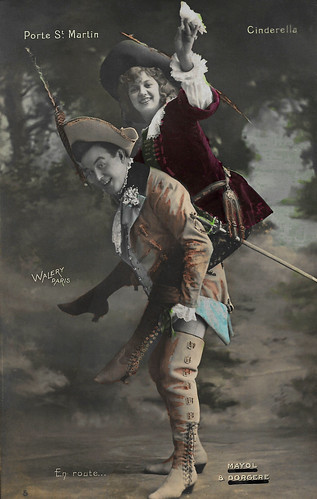
French postcard. Photo: Walery, Paris. Mayol as Dandy and Arlette Dorgère as Prince Charming in the stage production 'Cinderella' (1906) at Théâtre de la Porte Saint-Martin in Paris. Caption: en route.
Félix Mayol (1872-1941) was a popular French singer of the Belle Epoque. He became a success in Paris in 1895 as a singer performing in a campy, effeminate way. His hair tassel inspired many imitators. In 1905, he performed at Gaumont in 14 phonoscènes under the direction of Alice Guy.
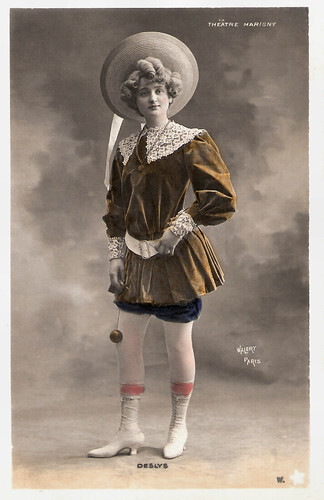
French postcard by Étoile, Série no. 677 - Th. 50. Papier Guileminot. Photo: Walery, Paris. Caption: la Theatre Marigny.
French dancer and actress Gaby Deslys (1881-1920) (aka Gaby Delys) was an internationally celebrated - and notorious - star of the early 20th Century. She was famous for her extravagant clothes, jewels, and millinery. She had many admirers, most notably King Manuel II of Portugal, and during World War I, she reportedly worked as a spy for the French government. Before her tragic early death, she also made a series of silent films.
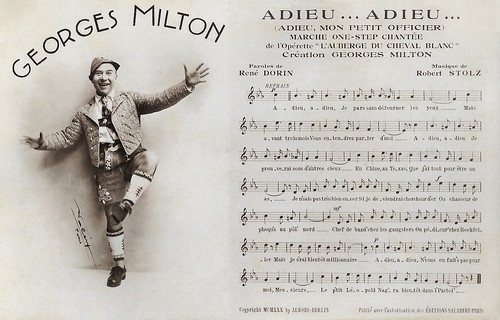
French postcard by Editions P-C, Paris, no. 114. Photo: Walery, Paris. Georges Milton sang the one-step march 'Adieu... Adieu...' (Adieu, mon petit officier) in the stage operetta 'L'auberge du cheval blanc' (The White Horse Inn). Text by René Dorin and music by Robert Stolz (music). Copyright: Alrobi, Berlin / Editions Salabert, Paris, in 1930.
Georges Milton (1886-1970) was a French singer and actor. With his daring, merry songs Milton expressed the atmosphere of the French roaring twenties. He peaked in the French cinema of the 1930s as the character Bouboule.
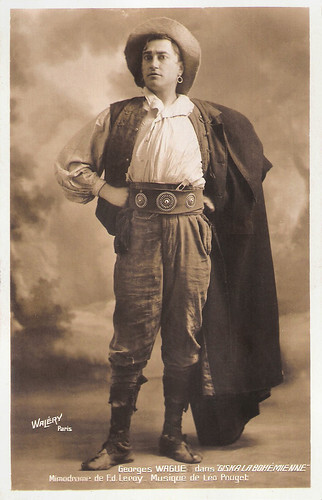
French postcard by Editions artistique de Walery. Photo: Walery, Paris. Publicity still for the play 'Giska la Bohémienne' (1908) by Ed. Leroy.
Georges Wague (1874-1965) was a French mime, teacher and silent film actor. Between 1907 and 1922 he also performed in more than forty films. He started his film career with the silent film L'Enfant prodigue/The Prodigal Son (Michel Carré, 1907), where he played a Pierrot. His last film performance was in Faust (Gérard Bourgeois, 1922).
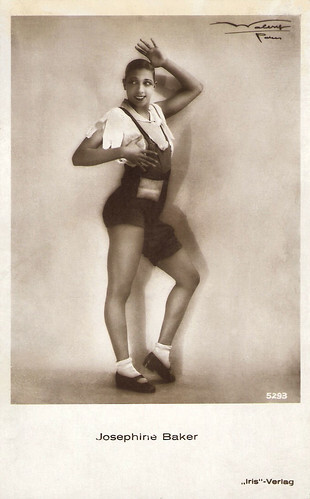
Austrian postcard by Iris Verlag, no. 5293. Photo: Walery, Paris.
Josephine Baker (1906-1975) was well-known as a singer and dancer. In 1925 she became an instant success in Paris, because of her erotic dance. She also performed in a handful of silent and early sound films, La Sirene des Tropiques (1927), Zouzou (1934) and La princesse TamTam (1935).
Sources: Wikipedia (French and English).

French postcard by Cinémagazine-Edition (CE), no. 531. Photo: Walery, Paris. Josephine Baker in La revue des revues/Parisian Pleasures (Joe Francis, 1927). Collection: Marlene Pilaete.
Josephine Baker (1906-1975) was well-known as a singer and dancer. In 1925 she became an instant success in Paris, because of her erotic dance. She also performed in a handful of silent and early sound films, La Sirene des Tropiques (1927), Zouzou (1934) and La princesse TamTam (1935).

Italian postcard by Ed. A. Traldi, Milano, no. 967. Photo: Walery. Collection: Marlene Pilaete. You will notice a difference between this postcard and the previous one: a bra covering Josephine Baker’s breasts. Italian editor Traldi chose to censor Josephine’s nakedness and print a retouched photo, possibly in a bout of prudery?

British postcard by Beagles Postcards, no. 707 C. Photo: Ellis & Walery. Publicity still for the stage play 'The Only Way'.
British Actor-manager Sir John Martin Harvey (1863-1944) was one of the last great romantic actors in the English theatre. His most famous play was 'The Only Way' (1899), an adaptation of Charles Dickens' 'A Tale of Two Cities'. 25 years later, he also featured in the film version, as well as in a few other silent and sound films.

British postcard by J. Beagles & Co, London, no. 515 S. Photo: Ellis & Walery.
Sir George Alexander (1858-1918) was an English actor and theatre manager. One of his most famous stage roles was in 'The Prisoner of Zenda' by Anthony Hope, which premiered in 1896.

British postcard by Rotary, no. 1212C. Photo: Ellis & Walery. Publicity still for the play 'The Devil's Disciple' (1907).
Tall and good-looking Matheson Lang (1879-1948) was a Canadian-born stage and film actor and playwright in the early 20th century. He is best known for his Shakespearean roles in British productions of 'Hamlet', 'Macbeth', and 'Romeo and Juliet' and for his role as Mr. Wu. He was one of the first major stars of the British theatre who acted in a silent film and during the 1920s, he became a popular film star in Great Britain.
A Regent Street studio
Stanisław Julian Ignacy Ostroróg was born in 1863 in London into a family of political emigrants of Polish noble descent. He was the eldest child of Count Stanisław Julian Ostroróg, a British subject and his Polish wife, Teodozja Waleria, née Gwozdecka. His father was born in the Russian Partition of what had once been the Polish–Lithuanian Commonwealth, not long after the November uprising of 1830 which led to severe repression of the insurgents, of which the family had been part.
After the war, his father settled in London and was granted citizenship in 1862 and married. After the birth of Stanisław junior, the family headed to Marseille to set up a photographic studio. In 1866 the family were back in Warsaw, but the following year after the death of the second son, they left for Paris in time for the birth of the third son, Leon. There Ostroróg senior resumed his successful photographic career under the brand name "Walery" (without an accent), in honour of his wife's first name.
In 1878 his creditor's financial difficulties forced him to give up trading and the family moved back to London in 1880. He opened a Regent Street studio where Stanisław junior was eventually to join his father.
Although born in England, Stanisław junior was sent to Poland, presumably to relatives, to learn Polish while his parents returned to France where his father developed his photographic career. In 1871, during the Paris Commune, he was sent there for his schooling. During that period, his parents divorced and his father remarried. At around 18 years of age and following family tradition, he obtained a commission in the army, only this time in the Royal Artillery at Woolwich. This was short-lived as he evinced an interest in his father's business and resigned from the army.
At his father's insistence, he went to Paris for two years to study the techniques of photography, including portraiture. He returned to England to rejoin his father, who by then was enjoying great success and found he was not needed in the studio and so accepted a proposal to go to Mexico for a year helping in the construction of a railway and opening up a colony. He spent the next few years travelling with a camera and survey instruments in Africa, to places like Natal and Zululand. The sudden death of his father from an aneurism brought him back to London, where he took over the management of his father's studio in 1890.

British postcard by J. Beagles & Co., London, no. 1408. Photo: Ellis & Walery.
English actress Eva Moore (1870–1955) had a career on stage and in the film which spanned six decades. She was active in the women's suffrage movement, and from 1920 on she appeared in over two dozen films.

British postcard by J. Beagles & Co., London, no. 747 E. Photo: Ellis and Walery. Publicity still for the stage production of The Lyons Mail (1905).
The play 'The Courier of Lyons' (1854) by Charles Reade was a very popular stage work of the Victorian era. A respectable French gentleman is mistaken for his doppelganger, a notorious highwayman. The double roles of the villain Dubosc and the hero Lesurques had been previously played by Henry Irving and, after his death, were taken on by his son, H.B. Irving . His stage version of The Lyons Mail was in 1916 turned into a British silent film with Irving again as Lesurques / Dubosc, but now without his wife Dorothea Baird in the cast. The film version was directed by Fred Paul and produced by the Ideal Film Company, one of the leading British silent film studios.

British postcard. Photo: Ellis & Walery. Publicity photo for a stage production of 'The Breed of the Treshams'.
John Martin Harvey played Reresby 'the Rat' in many stage productions between 19003 and 1934 as well as in the film The Breed of the Treshams (Kenelm Foss, 1920) with Mary Odette .

British postcard by J. Beagles & Co., Ltd., Printers & Publishers, no. 516 B. Photo: Ellis & Walery. Publicity photo for a stage production of 'The Prisoner of Zenda'.
Sir George Alexander (1858-1918) was an English actor and theatre manager. One of his most famous stage roles was in 'The Prisoner of Zenda' by Anthony Hope, which premiered in 1896.

British postcard by J. Beagles & Co., no. 273 L. Photo: Ellis & Walery. Photo: publicity still for the stage production of 'The Lyons Mail' (1905) with Irving as Lesurques.
H.B. Irving (1870-1919) was a British stage actor and actor-manager. He was the eldest son of Sir Henry Irving. Despite his many roles on stage and in the silent cinema, Irving is now best known for 'A Book of Remarkable Criminals' (1918), which he wrote as a legal expert.
A Paris studio in rue de Londres
Stanisław Ostroróg junior was inspired to learn photographic techniques by his photographer father. He had worked briefly alongside him in the London studio named after his mother, Walery Ltd. After his father's death, however, he found the business side a struggle and soon went into partnership with the ambitious young English theatrical photographer, Alfred Ellis (1854–1930) and began trading as Ellis & Walery from new premises in Baker Street until 1908.
For four years between 1890 and 1894, he worked on developing a Heliogravure process for the reproduction of art, although that did not produce the results he desired until much later in Paris. In the meantime, he continued with portraits of society people including royalty as his father had done earlier. The NPG records that Walery, father and son, is associated with 197 portraits, including comedian Dan Leno and King George V, while Ellis has 180 portraits to his name, mainly of "theatrical royalty". They appear to have kept their authorship and sitters separate while sharing studio facilities.
Around 1900, Stanisław Ostroróg opened a Paris studio on his own account, in his father's former premises, at 9bis rue de Londres, where initially he specialised in theatre and cabaret artists including Mata Hari and produced Cabinet cards. As his French business prospered he gave up his London interest in 1908. His Parisian clients included the Folies Bergères, the Société de Géographie, the salons de peintures, and a series for Les Grandes Figures médicales contemporaines. He was the official photographer for the 1912 Russian Season in Paris.
In the 1920s he focused on Art Photography and experimented with the figure of the model, entirely eschewing aspects of background and other perquisites. During this period he used the pseudonym "Laryew" and under that name produced a book of 100 heliogravures, entitled Nus – Cent Photographies Originales. He achieved the greatest acclaim with his series of photographs of Josephine Baker , published in 1926. He also produced studies of the female nude destined for anatomy and art students.
Stanisław Ostroróg married Joyce Audrey Rede Fowke (1877–1930), a granddaughter of Sir Henry Cole, in 1897 in Chelsea. They had four children, Francis who died in infancy, Stanislaus John, Joyce and Sally. During his career, he used numerous pseudonyms such as Lucien Waléry, Stanislas Walery, Laryew or Yrelaw (an anagram of Walery), the latter two perhaps to conceal a production of pictures of an erotic nature. Stanisław Julian Ignacy Ostroróg died in Paris in 1929. After his death, the studio was taken over by Charles Auguste Varsavaux (1866-1935).

French postcard. Photo: Walery, Paris. Mayol as Dandy and Arlette Dorgère as Prince Charming in the stage production 'Cinderella' (1906) at Théâtre de la Porte Saint-Martin in Paris. Caption: en route.
Félix Mayol (1872-1941) was a popular French singer of the Belle Epoque. He became a success in Paris in 1895 as a singer performing in a campy, effeminate way. His hair tassel inspired many imitators. In 1905, he performed at Gaumont in 14 phonoscènes under the direction of Alice Guy.

French postcard by Étoile, Série no. 677 - Th. 50. Papier Guileminot. Photo: Walery, Paris. Caption: la Theatre Marigny.
French dancer and actress Gaby Deslys (1881-1920) (aka Gaby Delys) was an internationally celebrated - and notorious - star of the early 20th Century. She was famous for her extravagant clothes, jewels, and millinery. She had many admirers, most notably King Manuel II of Portugal, and during World War I, she reportedly worked as a spy for the French government. Before her tragic early death, she also made a series of silent films.

French postcard by Editions P-C, Paris, no. 114. Photo: Walery, Paris. Georges Milton sang the one-step march 'Adieu... Adieu...' (Adieu, mon petit officier) in the stage operetta 'L'auberge du cheval blanc' (The White Horse Inn). Text by René Dorin and music by Robert Stolz (music). Copyright: Alrobi, Berlin / Editions Salabert, Paris, in 1930.
Georges Milton (1886-1970) was a French singer and actor. With his daring, merry songs Milton expressed the atmosphere of the French roaring twenties. He peaked in the French cinema of the 1930s as the character Bouboule.

French postcard by Editions artistique de Walery. Photo: Walery, Paris. Publicity still for the play 'Giska la Bohémienne' (1908) by Ed. Leroy.
Georges Wague (1874-1965) was a French mime, teacher and silent film actor. Between 1907 and 1922 he also performed in more than forty films. He started his film career with the silent film L'Enfant prodigue/The Prodigal Son (Michel Carré, 1907), where he played a Pierrot. His last film performance was in Faust (Gérard Bourgeois, 1922).

Austrian postcard by Iris Verlag, no. 5293. Photo: Walery, Paris.
Josephine Baker (1906-1975) was well-known as a singer and dancer. In 1925 she became an instant success in Paris, because of her erotic dance. She also performed in a handful of silent and early sound films, La Sirene des Tropiques (1927), Zouzou (1934) and La princesse TamTam (1935).
Sources: Wikipedia (French and English).
Published on August 13, 2022 22:00
August 12, 2022
Directed by Orson Welles
American actor, director, writer and producer Orson Welles (1915-1985) worked in theatre, radio and film, both in the US and in Europe. He is remembered for his innovative work in all three media, most notably Caesar (1937), a groundbreaking Broadway adaptation of 'Julius Caesar' and the debut of the Mercury Theatre, The War of the Worlds (1938), one of the most famous broadcasts in the history of radio, and Citizen Kane (1941), ranked as one of the all-time greatest films. His other films include The Magnificent Ambersons (1942), Touch of Evil (1958) and Le Procès/The Trial (1962).
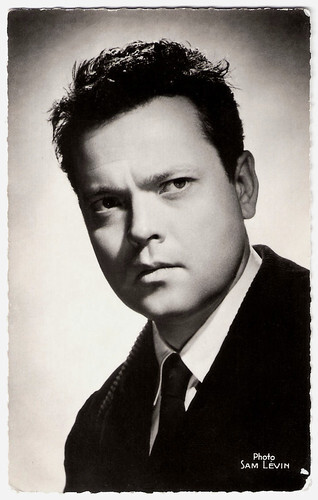
French postcard by Editions du Globe, no. 143. Photo: Sam Lévin.
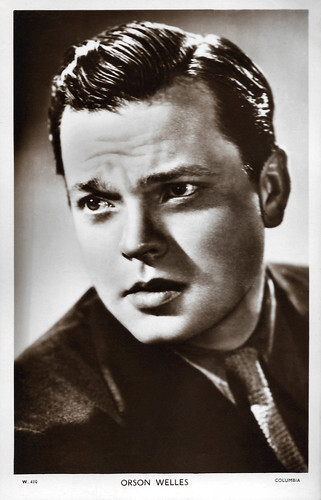
British postcard by Picturegoer, London, no. W. 410. Photo: Columbia. Orson Welles in The Lady from Shanghai (Orson Welles, 1947).
His brashness and impassioned quality
George Orson Welles was born in Kenosha, Wisconsin, in 1915. He was the second son of Beatrice (née Ives) and Richard Hodgdon Head Welles. In 1919, his parents separated and moved to Chicago. His father, who made a fortune as the inventor of a popular bicycle lamp, became an alcoholic and stopped working. His brother ‘Dickie’ was institutionalised at an early age because he had learning difficulties.
Welles's mother, a beautiful concert pianist, had to support her son and herself. In 1924, Beatrice died of hepatitis in a Chicago hospital, just after Welles's ninth birthday. He was taken in by Dudley Crafts Watson. At the age of ten, Orson ran away from home with Watson's third daughter, Marjorie. They were found a week later, singing and dancing for money on a street corner in Milwaukee.
Welles' father died when Orson was 15. Maurice Bernstein, a physician from Chicago, became his guardian. His school teacher Roger Hill provided Welles with an ad hoc educational environment that proved invaluable to his creative experience, allowing Welles to perform and stage theatrical experiments and productions.
Welles was awarded a scholarship to Harvard University, but he chose to travel to Europe instead. In Ireland, he strode into the Gate Theatre in Dublin and claimed he was a Broadway star. The manager of Gate, Hilton Edwards, was impressed by his brashness and impassioned quality in his audition. Welles made his stage debut at the Gate in 1931, appearing in 'Jew Suss' as the Duke. He acted to great acclaim, word of which reached the United States.
On returning to the United States he wrote the immensely successful 'Everybody's Shakespeare'. In 1933, he toured in three off-Broadway productions with Katharine Cornell's company, including two roles in 'Romeo and Juliet'. In 1934, he shot his first film, an eight-minute short titled The Hearts of Age, and he married Chicago actress Virginia Nicholson. By 1935 Welles was supplementing his earnings in the theatre as a radio actor, working with many actors who would later form the core of his Mercury Theatre.
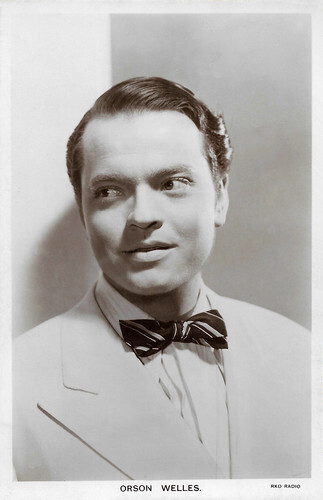
British postcard in the Picturegoer Series, London, no. W 130. Photo: RKO Radio.
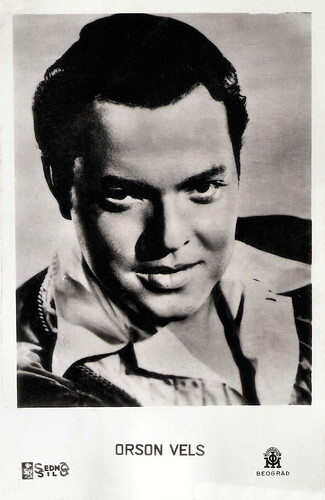
Yugoslavian postcard by Sedma Sila. Photo: IOM, Beograd. Orson Welles in Citizen Kane (Orson Welles, 1941). Caption: Orson Vels.
The Night That Panicked America
In 1936, the Federal Theatre Project (part of Roosevelt's Works Progress Administration) put unemployed theatre performers and employees to work. Orson Welles was hired by John Houseman and assigned to direct a play for the Federal Theatre Project's Negro Theatre Unit. His production of 'Macbeth' was set in the Haitian court of King Henri Christophe, with voodoo witch doctors for the three Weird Sisters. The play was received rapturously and later toured the nation.
At 20, Welles was hailed as a prodigy. A few minutes of Welles’ ‘Voodoo Macbeth’ was recorded on film in the documentary We Work Again (1937). Welles rehearsed Marc Blitzstein's political operetta, 'The Cradle Will Rock', but because of severe federal cutbacks in the Works Progress projects, the show's premiere at the Maxine Elliott Theatre was cancelled.
In a last-minute move, Welles announced to waiting ticket-holders that the show was being transferred to the Venice, twenty blocks away. Some cast, crew and audience members walked the distance on foot. Lacking the participation of the union members, 'The Cradle Will Rock' began with Blitzstein introducing the show and playing the piano accompaniment on stage with some cast members performing from the audience. This impromptu performance was well received and played at the Venice for two more weeks.
Welles and Houseman then formed the Mercury Theatre, of which Welles became the executive producer and whose repertory company eventually included the actors Agnes Moorehead, Joseph Cotten, Dolores del Río , Everett Sloane, and Erskine Sanford. The first Mercury Theatre production was William Shakespeare's tragedy 'Julius Caesar', set in a contemporary frame of fascist Italy. The production was widely acclaimed.
In the second year of the Mercury Theater, Welles shifted his interests to the radio. He adapted, directed and played 'Hamlet' for CBS and 'Les Misérables' for Mutual with great success. CBS gave the Mercury Theatre a weekly hour-long show to broadcast radio plays based on classic literary works. In 1938, their adaptation of 'The War of the Worlds' by H. G. Wells brought Welles instant fame. The combination of the news bulletin form of the performance with the between-breaks dial spinning habits of listeners from the rival more popular Edgar Bergen/Charlie McCarthy program was later reported in the media to have created widespread confusion.
Wikipedia : “Panic was reportedly spread among listeners who believed the news reports of a Martian invasion. The myth of the result created by the combination was reported as fact around the world and disparagingly mentioned by Adolf Hitler in a public speech some months later. The 1975 docudrama The Night That Panicked America was based on events centring on the production of, and events that resulted from the program.”
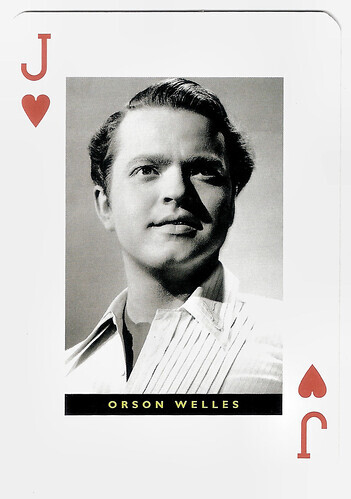
Vintage playcard. Photo: Ernest A. Bachrach. Orson Welles in Citizen Kane (Orson Welles, 1941).
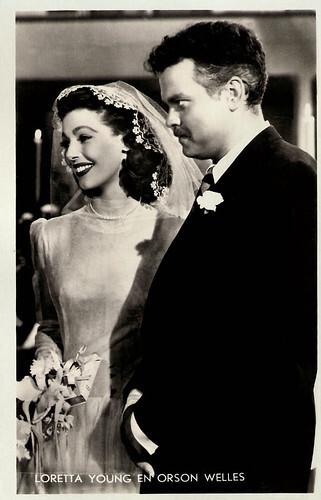
Dutch postcard by S. & v. H. A. Photo: M.P.E.A. Loretta Young and Orson Welles in The Stranger (Orson Welles, 1946).
The attempted suppression of Citizen Kane
Orson Welles's growing fame drew Hollywood offers, lures that the independent-minded Welles resisted at first. RKO Radio Pictures president George Schaefer eventually offered him complete artistic control and signed Welles in a two-picture deal, although Welles had a budget limit for his projects. In Hollywood, Welles toyed with various ideas for his first project.
RKO rejected Welles's first two movie proposals but agreed on the third offer, Citizen Kane (1941), for which Welles co-wrote, produced, directed and performed the lead role. Co-scriptwriter Joseph Mankiewicz based the original outline on an exposé of the life of William Randolph Hearst, whom he knew socially and came to hate, having once been great friends with Hearst's mistress, Marion Davies .
Kane's megalomania was modelled loosely on Robert McCormick, Howard Hughes and Joseph Pulitzer as Welles wanted to create a broad, complex character, intending to show him in the same scenes from several points of view. On Welles's instruction, John Houseman wrote the opening narration as a pastiche of The March of Time newsreels. Autobiographical allusions to Welles were worked in, most noticeably in the treatment of Kane's childhood and particularly, regarding his guardianship.
Once the script was complete, Welles attracted cinematographer Gregg Toland, and actors from his Mercury Theatre. After gossip columnist Hedda Hopper saw a preview screening of Citizen Kane, the attempted suppression of Citizen Kane started. Hearst's media outlets boycotted the film. They exerted enormous pressure on Hollywood, but RKO gave the film a limited release.
The film was well-received critically and garnered nine Academy Award nominations. Welles was nominated as a producer, director, writer and actor, but won only for Best Original Screenplay, shared with Mankiewicz. Today, the film is considered by most film critics and historians to be one of the classics in film history.
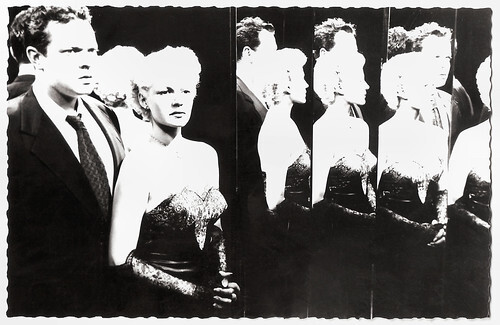
Vintage postcard. Photo: Edward Cronenweth. Orson Welles and Rita Hayworth in The Lady From Shanghai (Orson Welles, 1947).
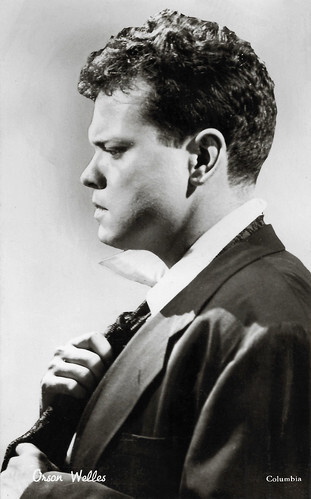
Vintage postcard. Photo: Columbia. Orson Welles in The Lady From Shanghai (Orson Welles, 1947).
A climactic confrontation scene in an amusement park funhouse
Orson Welles's second film for RKO was The Magnificent Ambersons (1942), adapted from the Pulitzer Prize-winning novel by Booth Tarkington. At RKO's request, Welles worked also on an adaptation of Eric Ambler's spy thriller, Journey into Fear (Norman Foster, 1943), co-written with Joseph Cotten . In addition to acting in the film, Welles was the producer.
Changes throughout RKO caused re-evaluations of both projects. RKO took control of The Magnificent Ambersons and ordered to edit the film into a ‘commercial’ format. They removed fifty minutes of Welles's footage, re-shot sequences, rearranged the scene order, and added a happy ending. It resulted in an expensive flop for RKO, although The Magnificent Ambersons received four Academy Award nominations including Best Picture and Best Supporting Actress for Agnes Moorehead.
Welles found no studios interested in him as a director after the disaster of The Magnificent Ambersons and worked on radio. In 1943, he married Rita Hayworth . They had one child, Rebecca Welles, and divorced five years later in 1948. In between, Welles found work as an actor in other films. He starred in the film adaptation of Jane Eyre (Robert Stevenson, 1944), trading credit as associate producer for top billing over Joan Fontaine. He had a cameo in the wartime salute Follow the Boys (A. Edward Sutherland, 1944), in which he performed his magic act ‘sawing’ Marlene Dietrich in half.
In 1946, Sam Spiegel produced The Stranger (Orson Welles, 1946), starring Edward G. Robinson , Loretta Young and Welles. The film follows the hunt for a Nazi war criminal living under an alias in the United States. Although disputes occurred during editing between Spiegel and Welles, the film was a box office success and it helped his standing with the studios.
He then filmed The Lady from Shanghai (Orson Welles, 1947) for Columbia Pictures, in which his then-estranged second wife Rita Hayworth co-starred. Cohn disliked Welles's rough-cut and ordered extensive editing and re-shoots. Approximately one hour of Welles's first cut was removed, including much of a climactic confrontation scene in an amusement park funhouse. The film was considered a disaster in America at the time of release, though the closing shootout in a hall of mirrors has since become a touchstone of Film Noir.
Welles convinced Republic Pictures to let him direct a low-budget version of Macbeth (Orson Welles, 1948). Republic initially trumpeted the film as an important work but decided it did not care for the Scottish accents and held up general release for almost a year after the early negative press reaction. In the late 1970s, a fully restored version of Macbeth was released that followed Welles's original vision.
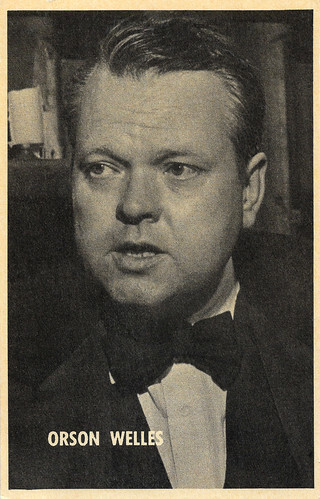
Belgian postcard by International Lotto Club, Monte-Carlo.
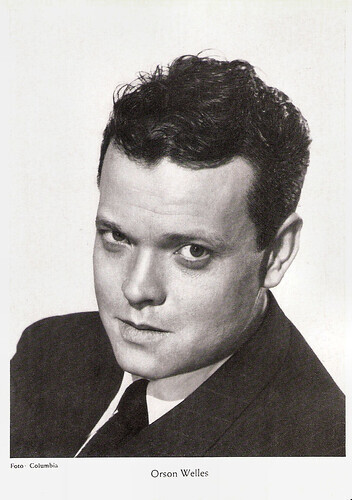
Vintage card. Photo: Columbia.
An international smash hit
Orson Welles left Hollywood for Europe. In Italy, he starred as Cagliostro in Black Magic (Gregory Ratoff, 1948) with Akim Tamiroff. His co-star impressed Welles so much that Tamiroff would appear in four of Welles's later productions. Welles starred as Harry Lime in Carol Reed's The Third Man (1949), alongside Joseph Cotten . The film was an international smash hit.
Welles also appeared as Cesare Borgia in the Italian film Prince of Foxes (Henry King, 1949), and as the Mongol warrior Bayan in The Black Rose (Henry Hathaway, 1950), both with Tyrone Power . Welles was channelling his money from acting jobs into a self-financed film version of Shakespeare's play Othello. From 1949 to 1951, Welles filmed Othello (1952) on location in Europe and Morocco. Suzanne Cloutier co-starred as Desdemona. When it premiered at the Cannes Film Festival it won the Palme d'Or, but the film did not receive a general release in the United States until 1955.
Welles's daughter, Beatrice Welles-Smith, restored Othello in 1992 for a wide re-release. Welles played the murdered victim in Trent's Last Case (Herbert Wilcox, 1952) and the title role in the 'Lord Mountdrago' segment of Three Cases of Murder (George More O'Ferrall, 1954). Herbert Wilcox cast Welles as the antagonist in Trouble in the Glen (1954) opposite Margaret Lockwood , and John Huston cast him as Father Mapple in Moby-Dick (1956), starring Gregory Peck .
Welles's next turn as director was Mr. Arkadin (Orson Welles, 1955), filmed in France, Germany, Spain and Italy on a very limited budget. Welles played a billionaire who hires a man (Robert Arden) to delve into the secrets of his past. The film co-starred Welles's third wife, Paola Mori. Frustrated by his slow progress in the editing room, producer Louis Dolivet removed Welles from the project and finished the film without him as Confidential Report.
In 1956, Welles returned to Hollywood and guest-starred on radio and television shows. His next film role was in Man in the Shadow (Jack Arnold, 1957) for Universal Pictures, starring Jeff Chandler. Around this time period, Welles began to suffer from weight problems that would eventually cause a deterioration in his health.
Welles stayed on at Universal to co-star with Charlton Heston in Touch of Evil (Orson Welles, 1958). Originally only hired as an actor, Welles was promoted to director by Universal at the insistence of Heston. He reunited with many actors and technicians with whom he had worked in the 1940s including Joseph Cotten , Marlene Dietrich and Akim Tamiroff. Filming proceeded smoothly, but after the end of production, the studio re-edited the film, re-shot scenes, and shot new exposition scenes to clarify the plot. In 1978, a longer preview version of the film was discovered and released.
Next, Welles filmed his adaptation of Miguel de Cervantes' novel 'Don Quixote in Mexico' starring Mischa Auer as Quixote and Akim Tamiroff as Sancho Panza. While filming would continue in fits and starts for several years, Welles would never complete the project. Welles continued acting, notably in The Long, Hot Summer (Marin Ritt, 1958) and Compulsion (Richard Fleischer, 1959), but soon he returned to Europe.
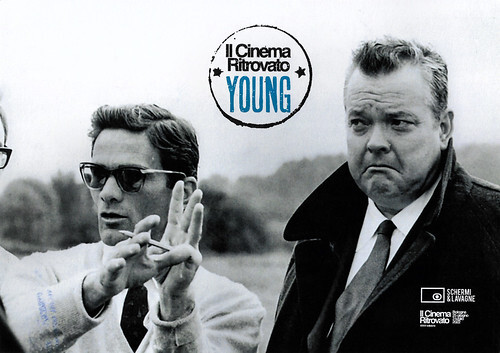
Big programme card by Cineteca Bologna for Il Cinema Ritrovato, XXXVI edizione, Selezione Cinema Ritrovato Young, 30 June 2022. Pierr Paolo Pasolini and Orson Welles on the set of La Ricotta (Pier Paolo Pasolini, 1963).La Ricotta was an episode of the anthology film Ep.di.Ro.Go.Pa.G. (1963).
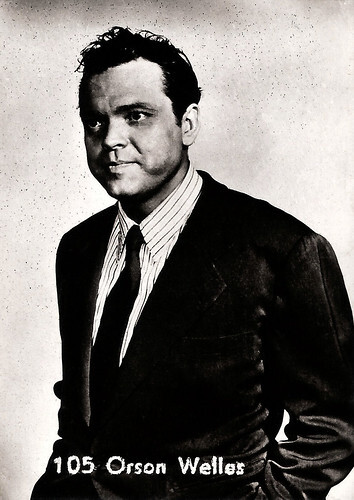
Small Belgian collectors card by Belgian Chewing Gum Ltd., Antwerp, no. 105.
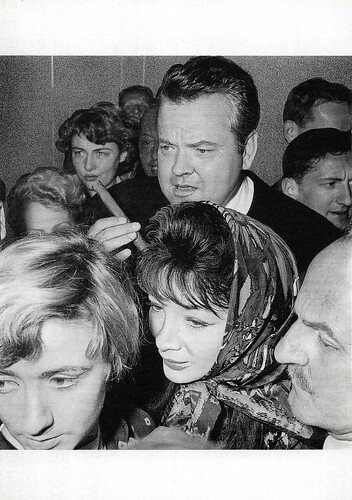
French postcard in the Collection Cinéma by Editions La Malibran, Paris, 1990, no. CF 69. Caption: Orson Welles - Françoise Sagan - Juliette Greco - Daryl Zanuck - Mai 59. On 5 May 1959, Orson Welles was photographed at the Cannes Film Festival with Francoise Sagan, Darryl F. Zanuck and Juliette Greco. Orson Welles's shown film Compulsion' (Richard Fleischers, 1959) scored a great success. Francoise Sagan was said to be negotiating with Zanuck and Welles for a film based on one of her latest novels.
Kafka
In Italy, Orson Welles directed his own scenes as King Saul in David e Golia/David and Goliath (Ferdinando Baldi, Richard Pottier, 1959). In Hong Kong, he co-starred with Curt Jürgens in Ferry to Hong Kong (Lewis Gilbert, 1959). In Paris, he co-starred in Crack in the Mirror (Richard Fleischer, 1960). In Yugoslavia, he starred in I tartari/The Tartars (Richard Thorpe, 1962) and Bitka na Neretvi/Battle of Neretva (Veljko Bulajić, 1969).
In 1962, Welles directed Le Procès/The Trial (Orson Welles, 1962), based on the novel by Franz Kafka and starring Anthony Perkins as Josef K, Jeanne Moreau and Romy Schneider. The film failed at the box office, but during the filming, he met Oja Kodar, who became his muse, star and mistress for the rest of his life.
Welles played a film director in La Ricotta (1963), Pier Paolo Pasolini's segment of the anthology film Ro.Go.Pa.G. He continued taking what work he could find acting, narrating or hosting other people's work, and began filming Campanadas a medianoche/Chimes at Midnight (Orson Welles, 1966). Filmed in Spain, it was a condensation of five Shakespeare plays, telling the story of Falstaff (Welles) and his relationship with Prince Hal (Keith Baxter).
Then followed Histoire immortelle/The Immortal Story (Orson Welles, 1968) with Jeanne Moreau , which had a successful run in French theatres. He appeared as Cardinal Wolsey in A Man for All Seasons (Fred Zinnemann, 1966) for which he won considerable acclaim. Welles began directing The Deep, based on the novel 'Dead Calm' by Charles Williams and filmed off the shore of Yugoslavia. The cast included Jeanne Moreau , Laurence Harvey and Oja Kodar.
Personally financed by Welles and Kodar, they could not obtain the funds to complete the project, and it was abandoned a few years later after the death of Harvey. The surviving footage was eventually edited and released by the Filmmuseum München. In 1969, Welles played a supporting role in John Huston's The Kremlin Letter. Drawn by the numerous offers he received to work in television and films, and upset by a tabloid scandal reporting his affair with Kodar, Welles moved back to America in 1970.
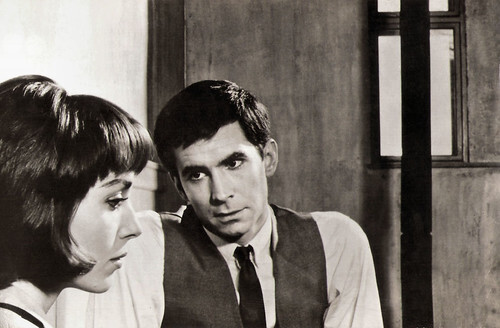
Romanian postcard by Casa Filmului Acin, no. 470. Photo: Elsa Martinelli and Anthony Perkins in Le procès/The Trial (Orson Welles, 1962). Sent by mail in 1972.
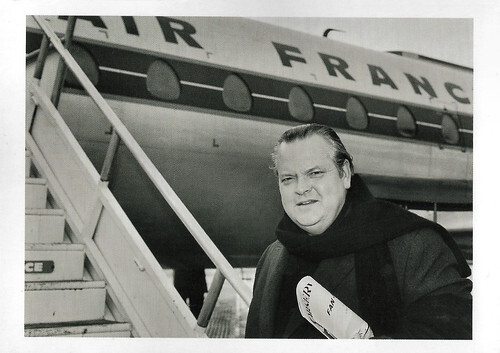
French postcard by Editions F. Nugeron, no. Star 130. Photo: Air France / Distribution VU. Caption: Orson Wells (sic), Septembre 1967.
The Dreamers
In Hollywood, Orson Welles continued to self-finance his own film and television projects. While offers to act, narrate and host continued, Welles also found himself in great demand on television talk shows. His primary focus during his final years was The Other Side of the Wind, an unfinished project that was filmed intermittently between 1970 and 1976. Written by Welles, it is the story of an ageing film director (John Huston) looking for funds to complete his final film. Financed by Iranian backers, ownership of the film fell into a legal quagmire after the Shah of Iran was deposed, and disputes still prevent its release.
Welles portrayed Louis XVIII of France in Waterloo (Sergey Bondarchuk, 1970), and narrated the historical comedy Start the Revolution Without Me (Bud Yorkin, 1970). He appeared in La décade prodigieuse/Ten Days' Wonder (Claude Chabrol, 1971), co-starring with Anthony Perkins . Wikipedia: “That same year, the Academy of Motion Picture Arts and Sciences gave him an honorary award "For superlative artistry and versatility in the creation of motion pictures". Welles pretended to be out of town and sent John Huston to claim the award. Huston criticised the Academy for awarding Welles, even while they refused to give Welles any work.”
Welles played Long John Silver in Treasure Island (John Hough, 1972), an adaptation of the Robert Louis Stevenson novel. He completed F for Fake (Orson Welles, 1973), a personal essay film about art forger Elmyr de Hory and the biographer Clifford Irving, and his documentary Filming Othello (Orson Welles, 1979).
During the 1980s, Welles worked on such film projects as The Dreamers, based on two stories by Isak Dinesen. His last film appearance was in Henry Jaglom's Someone to Love (1987), released after his death.
Welles had three daughters: Chris Welles Feder (1938), with Virginia Nicholson; Rebecca Welles Manning (1944–2004), with Rita Hayworth ; and Beatrice Welles (1955), with Paola Mori. His only known son, British director Michael Lindsay-Hogg (1940), is from Welles's affair with Irish actress Geraldine Fitzgerald, then the wife of Sir Edward Lindsay-Hogg, 4th baronet.
On 10 October 1985, Orson Welles appeared in his final interview on The Merv Griffin Show. He died several hours later of a heart attack at his home in Los Angeles. His estranged wife Paola Mori refused to allow most of Welles's friends to attend the funeral, limiting the mourners to just nine: herself, Welles's three daughters, Roger Hill, and three of Welles's friends, as well as the doctor who had signed Welles's death certificate.
Welles's companion for the last 20 years, Oja Kodar, was not invited, nor were either of his ex-wives. Welles's ashes were taken to Ronda, Spain, where they were buried in an old well covered by flowers, within the rural property of a long-time friend, retired bullfighter Antonio Ordóñez.
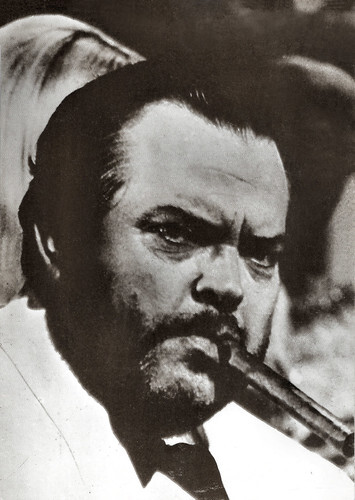
French postcard by Delta Productions, Montpellier, no. CP152. Orson Welles in Casino Royale (Val Guest, Ken Hughes, John Huston, 1967).
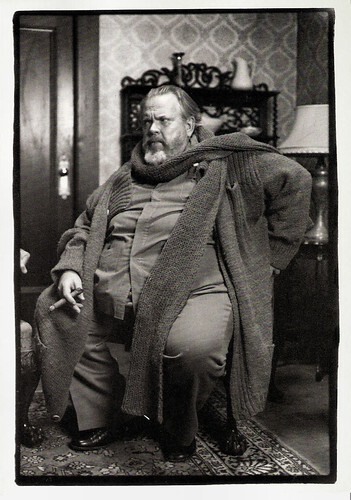
American postcard by Fotofolio, New York, N.Y., no. P27. Photo: Timothy Greenfield-Sanders. Caption: Orson Welles, 1979.
Sources: (IMDb), Wikipedia, and .

French postcard by Editions du Globe, no. 143. Photo: Sam Lévin.

British postcard by Picturegoer, London, no. W. 410. Photo: Columbia. Orson Welles in The Lady from Shanghai (Orson Welles, 1947).
His brashness and impassioned quality
George Orson Welles was born in Kenosha, Wisconsin, in 1915. He was the second son of Beatrice (née Ives) and Richard Hodgdon Head Welles. In 1919, his parents separated and moved to Chicago. His father, who made a fortune as the inventor of a popular bicycle lamp, became an alcoholic and stopped working. His brother ‘Dickie’ was institutionalised at an early age because he had learning difficulties.
Welles's mother, a beautiful concert pianist, had to support her son and herself. In 1924, Beatrice died of hepatitis in a Chicago hospital, just after Welles's ninth birthday. He was taken in by Dudley Crafts Watson. At the age of ten, Orson ran away from home with Watson's third daughter, Marjorie. They were found a week later, singing and dancing for money on a street corner in Milwaukee.
Welles' father died when Orson was 15. Maurice Bernstein, a physician from Chicago, became his guardian. His school teacher Roger Hill provided Welles with an ad hoc educational environment that proved invaluable to his creative experience, allowing Welles to perform and stage theatrical experiments and productions.
Welles was awarded a scholarship to Harvard University, but he chose to travel to Europe instead. In Ireland, he strode into the Gate Theatre in Dublin and claimed he was a Broadway star. The manager of Gate, Hilton Edwards, was impressed by his brashness and impassioned quality in his audition. Welles made his stage debut at the Gate in 1931, appearing in 'Jew Suss' as the Duke. He acted to great acclaim, word of which reached the United States.
On returning to the United States he wrote the immensely successful 'Everybody's Shakespeare'. In 1933, he toured in three off-Broadway productions with Katharine Cornell's company, including two roles in 'Romeo and Juliet'. In 1934, he shot his first film, an eight-minute short titled The Hearts of Age, and he married Chicago actress Virginia Nicholson. By 1935 Welles was supplementing his earnings in the theatre as a radio actor, working with many actors who would later form the core of his Mercury Theatre.

British postcard in the Picturegoer Series, London, no. W 130. Photo: RKO Radio.

Yugoslavian postcard by Sedma Sila. Photo: IOM, Beograd. Orson Welles in Citizen Kane (Orson Welles, 1941). Caption: Orson Vels.
The Night That Panicked America
In 1936, the Federal Theatre Project (part of Roosevelt's Works Progress Administration) put unemployed theatre performers and employees to work. Orson Welles was hired by John Houseman and assigned to direct a play for the Federal Theatre Project's Negro Theatre Unit. His production of 'Macbeth' was set in the Haitian court of King Henri Christophe, with voodoo witch doctors for the three Weird Sisters. The play was received rapturously and later toured the nation.
At 20, Welles was hailed as a prodigy. A few minutes of Welles’ ‘Voodoo Macbeth’ was recorded on film in the documentary We Work Again (1937). Welles rehearsed Marc Blitzstein's political operetta, 'The Cradle Will Rock', but because of severe federal cutbacks in the Works Progress projects, the show's premiere at the Maxine Elliott Theatre was cancelled.
In a last-minute move, Welles announced to waiting ticket-holders that the show was being transferred to the Venice, twenty blocks away. Some cast, crew and audience members walked the distance on foot. Lacking the participation of the union members, 'The Cradle Will Rock' began with Blitzstein introducing the show and playing the piano accompaniment on stage with some cast members performing from the audience. This impromptu performance was well received and played at the Venice for two more weeks.
Welles and Houseman then formed the Mercury Theatre, of which Welles became the executive producer and whose repertory company eventually included the actors Agnes Moorehead, Joseph Cotten, Dolores del Río , Everett Sloane, and Erskine Sanford. The first Mercury Theatre production was William Shakespeare's tragedy 'Julius Caesar', set in a contemporary frame of fascist Italy. The production was widely acclaimed.
In the second year of the Mercury Theater, Welles shifted his interests to the radio. He adapted, directed and played 'Hamlet' for CBS and 'Les Misérables' for Mutual with great success. CBS gave the Mercury Theatre a weekly hour-long show to broadcast radio plays based on classic literary works. In 1938, their adaptation of 'The War of the Worlds' by H. G. Wells brought Welles instant fame. The combination of the news bulletin form of the performance with the between-breaks dial spinning habits of listeners from the rival more popular Edgar Bergen/Charlie McCarthy program was later reported in the media to have created widespread confusion.
Wikipedia : “Panic was reportedly spread among listeners who believed the news reports of a Martian invasion. The myth of the result created by the combination was reported as fact around the world and disparagingly mentioned by Adolf Hitler in a public speech some months later. The 1975 docudrama The Night That Panicked America was based on events centring on the production of, and events that resulted from the program.”

Vintage playcard. Photo: Ernest A. Bachrach. Orson Welles in Citizen Kane (Orson Welles, 1941).

Dutch postcard by S. & v. H. A. Photo: M.P.E.A. Loretta Young and Orson Welles in The Stranger (Orson Welles, 1946).
The attempted suppression of Citizen Kane
Orson Welles's growing fame drew Hollywood offers, lures that the independent-minded Welles resisted at first. RKO Radio Pictures president George Schaefer eventually offered him complete artistic control and signed Welles in a two-picture deal, although Welles had a budget limit for his projects. In Hollywood, Welles toyed with various ideas for his first project.
RKO rejected Welles's first two movie proposals but agreed on the third offer, Citizen Kane (1941), for which Welles co-wrote, produced, directed and performed the lead role. Co-scriptwriter Joseph Mankiewicz based the original outline on an exposé of the life of William Randolph Hearst, whom he knew socially and came to hate, having once been great friends with Hearst's mistress, Marion Davies .
Kane's megalomania was modelled loosely on Robert McCormick, Howard Hughes and Joseph Pulitzer as Welles wanted to create a broad, complex character, intending to show him in the same scenes from several points of view. On Welles's instruction, John Houseman wrote the opening narration as a pastiche of The March of Time newsreels. Autobiographical allusions to Welles were worked in, most noticeably in the treatment of Kane's childhood and particularly, regarding his guardianship.
Once the script was complete, Welles attracted cinematographer Gregg Toland, and actors from his Mercury Theatre. After gossip columnist Hedda Hopper saw a preview screening of Citizen Kane, the attempted suppression of Citizen Kane started. Hearst's media outlets boycotted the film. They exerted enormous pressure on Hollywood, but RKO gave the film a limited release.
The film was well-received critically and garnered nine Academy Award nominations. Welles was nominated as a producer, director, writer and actor, but won only for Best Original Screenplay, shared with Mankiewicz. Today, the film is considered by most film critics and historians to be one of the classics in film history.

Vintage postcard. Photo: Edward Cronenweth. Orson Welles and Rita Hayworth in The Lady From Shanghai (Orson Welles, 1947).

Vintage postcard. Photo: Columbia. Orson Welles in The Lady From Shanghai (Orson Welles, 1947).
A climactic confrontation scene in an amusement park funhouse
Orson Welles's second film for RKO was The Magnificent Ambersons (1942), adapted from the Pulitzer Prize-winning novel by Booth Tarkington. At RKO's request, Welles worked also on an adaptation of Eric Ambler's spy thriller, Journey into Fear (Norman Foster, 1943), co-written with Joseph Cotten . In addition to acting in the film, Welles was the producer.
Changes throughout RKO caused re-evaluations of both projects. RKO took control of The Magnificent Ambersons and ordered to edit the film into a ‘commercial’ format. They removed fifty minutes of Welles's footage, re-shot sequences, rearranged the scene order, and added a happy ending. It resulted in an expensive flop for RKO, although The Magnificent Ambersons received four Academy Award nominations including Best Picture and Best Supporting Actress for Agnes Moorehead.
Welles found no studios interested in him as a director after the disaster of The Magnificent Ambersons and worked on radio. In 1943, he married Rita Hayworth . They had one child, Rebecca Welles, and divorced five years later in 1948. In between, Welles found work as an actor in other films. He starred in the film adaptation of Jane Eyre (Robert Stevenson, 1944), trading credit as associate producer for top billing over Joan Fontaine. He had a cameo in the wartime salute Follow the Boys (A. Edward Sutherland, 1944), in which he performed his magic act ‘sawing’ Marlene Dietrich in half.
In 1946, Sam Spiegel produced The Stranger (Orson Welles, 1946), starring Edward G. Robinson , Loretta Young and Welles. The film follows the hunt for a Nazi war criminal living under an alias in the United States. Although disputes occurred during editing between Spiegel and Welles, the film was a box office success and it helped his standing with the studios.
He then filmed The Lady from Shanghai (Orson Welles, 1947) for Columbia Pictures, in which his then-estranged second wife Rita Hayworth co-starred. Cohn disliked Welles's rough-cut and ordered extensive editing and re-shoots. Approximately one hour of Welles's first cut was removed, including much of a climactic confrontation scene in an amusement park funhouse. The film was considered a disaster in America at the time of release, though the closing shootout in a hall of mirrors has since become a touchstone of Film Noir.
Welles convinced Republic Pictures to let him direct a low-budget version of Macbeth (Orson Welles, 1948). Republic initially trumpeted the film as an important work but decided it did not care for the Scottish accents and held up general release for almost a year after the early negative press reaction. In the late 1970s, a fully restored version of Macbeth was released that followed Welles's original vision.

Belgian postcard by International Lotto Club, Monte-Carlo.

Vintage card. Photo: Columbia.
An international smash hit
Orson Welles left Hollywood for Europe. In Italy, he starred as Cagliostro in Black Magic (Gregory Ratoff, 1948) with Akim Tamiroff. His co-star impressed Welles so much that Tamiroff would appear in four of Welles's later productions. Welles starred as Harry Lime in Carol Reed's The Third Man (1949), alongside Joseph Cotten . The film was an international smash hit.
Welles also appeared as Cesare Borgia in the Italian film Prince of Foxes (Henry King, 1949), and as the Mongol warrior Bayan in The Black Rose (Henry Hathaway, 1950), both with Tyrone Power . Welles was channelling his money from acting jobs into a self-financed film version of Shakespeare's play Othello. From 1949 to 1951, Welles filmed Othello (1952) on location in Europe and Morocco. Suzanne Cloutier co-starred as Desdemona. When it premiered at the Cannes Film Festival it won the Palme d'Or, but the film did not receive a general release in the United States until 1955.
Welles's daughter, Beatrice Welles-Smith, restored Othello in 1992 for a wide re-release. Welles played the murdered victim in Trent's Last Case (Herbert Wilcox, 1952) and the title role in the 'Lord Mountdrago' segment of Three Cases of Murder (George More O'Ferrall, 1954). Herbert Wilcox cast Welles as the antagonist in Trouble in the Glen (1954) opposite Margaret Lockwood , and John Huston cast him as Father Mapple in Moby-Dick (1956), starring Gregory Peck .
Welles's next turn as director was Mr. Arkadin (Orson Welles, 1955), filmed in France, Germany, Spain and Italy on a very limited budget. Welles played a billionaire who hires a man (Robert Arden) to delve into the secrets of his past. The film co-starred Welles's third wife, Paola Mori. Frustrated by his slow progress in the editing room, producer Louis Dolivet removed Welles from the project and finished the film without him as Confidential Report.
In 1956, Welles returned to Hollywood and guest-starred on radio and television shows. His next film role was in Man in the Shadow (Jack Arnold, 1957) for Universal Pictures, starring Jeff Chandler. Around this time period, Welles began to suffer from weight problems that would eventually cause a deterioration in his health.
Welles stayed on at Universal to co-star with Charlton Heston in Touch of Evil (Orson Welles, 1958). Originally only hired as an actor, Welles was promoted to director by Universal at the insistence of Heston. He reunited with many actors and technicians with whom he had worked in the 1940s including Joseph Cotten , Marlene Dietrich and Akim Tamiroff. Filming proceeded smoothly, but after the end of production, the studio re-edited the film, re-shot scenes, and shot new exposition scenes to clarify the plot. In 1978, a longer preview version of the film was discovered and released.
Next, Welles filmed his adaptation of Miguel de Cervantes' novel 'Don Quixote in Mexico' starring Mischa Auer as Quixote and Akim Tamiroff as Sancho Panza. While filming would continue in fits and starts for several years, Welles would never complete the project. Welles continued acting, notably in The Long, Hot Summer (Marin Ritt, 1958) and Compulsion (Richard Fleischer, 1959), but soon he returned to Europe.

Big programme card by Cineteca Bologna for Il Cinema Ritrovato, XXXVI edizione, Selezione Cinema Ritrovato Young, 30 June 2022. Pierr Paolo Pasolini and Orson Welles on the set of La Ricotta (Pier Paolo Pasolini, 1963).La Ricotta was an episode of the anthology film Ep.di.Ro.Go.Pa.G. (1963).

Small Belgian collectors card by Belgian Chewing Gum Ltd., Antwerp, no. 105.

French postcard in the Collection Cinéma by Editions La Malibran, Paris, 1990, no. CF 69. Caption: Orson Welles - Françoise Sagan - Juliette Greco - Daryl Zanuck - Mai 59. On 5 May 1959, Orson Welles was photographed at the Cannes Film Festival with Francoise Sagan, Darryl F. Zanuck and Juliette Greco. Orson Welles's shown film Compulsion' (Richard Fleischers, 1959) scored a great success. Francoise Sagan was said to be negotiating with Zanuck and Welles for a film based on one of her latest novels.
Kafka
In Italy, Orson Welles directed his own scenes as King Saul in David e Golia/David and Goliath (Ferdinando Baldi, Richard Pottier, 1959). In Hong Kong, he co-starred with Curt Jürgens in Ferry to Hong Kong (Lewis Gilbert, 1959). In Paris, he co-starred in Crack in the Mirror (Richard Fleischer, 1960). In Yugoslavia, he starred in I tartari/The Tartars (Richard Thorpe, 1962) and Bitka na Neretvi/Battle of Neretva (Veljko Bulajić, 1969).
In 1962, Welles directed Le Procès/The Trial (Orson Welles, 1962), based on the novel by Franz Kafka and starring Anthony Perkins as Josef K, Jeanne Moreau and Romy Schneider. The film failed at the box office, but during the filming, he met Oja Kodar, who became his muse, star and mistress for the rest of his life.
Welles played a film director in La Ricotta (1963), Pier Paolo Pasolini's segment of the anthology film Ro.Go.Pa.G. He continued taking what work he could find acting, narrating or hosting other people's work, and began filming Campanadas a medianoche/Chimes at Midnight (Orson Welles, 1966). Filmed in Spain, it was a condensation of five Shakespeare plays, telling the story of Falstaff (Welles) and his relationship with Prince Hal (Keith Baxter).
Then followed Histoire immortelle/The Immortal Story (Orson Welles, 1968) with Jeanne Moreau , which had a successful run in French theatres. He appeared as Cardinal Wolsey in A Man for All Seasons (Fred Zinnemann, 1966) for which he won considerable acclaim. Welles began directing The Deep, based on the novel 'Dead Calm' by Charles Williams and filmed off the shore of Yugoslavia. The cast included Jeanne Moreau , Laurence Harvey and Oja Kodar.
Personally financed by Welles and Kodar, they could not obtain the funds to complete the project, and it was abandoned a few years later after the death of Harvey. The surviving footage was eventually edited and released by the Filmmuseum München. In 1969, Welles played a supporting role in John Huston's The Kremlin Letter. Drawn by the numerous offers he received to work in television and films, and upset by a tabloid scandal reporting his affair with Kodar, Welles moved back to America in 1970.

Romanian postcard by Casa Filmului Acin, no. 470. Photo: Elsa Martinelli and Anthony Perkins in Le procès/The Trial (Orson Welles, 1962). Sent by mail in 1972.

French postcard by Editions F. Nugeron, no. Star 130. Photo: Air France / Distribution VU. Caption: Orson Wells (sic), Septembre 1967.
The Dreamers
In Hollywood, Orson Welles continued to self-finance his own film and television projects. While offers to act, narrate and host continued, Welles also found himself in great demand on television talk shows. His primary focus during his final years was The Other Side of the Wind, an unfinished project that was filmed intermittently between 1970 and 1976. Written by Welles, it is the story of an ageing film director (John Huston) looking for funds to complete his final film. Financed by Iranian backers, ownership of the film fell into a legal quagmire after the Shah of Iran was deposed, and disputes still prevent its release.
Welles portrayed Louis XVIII of France in Waterloo (Sergey Bondarchuk, 1970), and narrated the historical comedy Start the Revolution Without Me (Bud Yorkin, 1970). He appeared in La décade prodigieuse/Ten Days' Wonder (Claude Chabrol, 1971), co-starring with Anthony Perkins . Wikipedia: “That same year, the Academy of Motion Picture Arts and Sciences gave him an honorary award "For superlative artistry and versatility in the creation of motion pictures". Welles pretended to be out of town and sent John Huston to claim the award. Huston criticised the Academy for awarding Welles, even while they refused to give Welles any work.”
Welles played Long John Silver in Treasure Island (John Hough, 1972), an adaptation of the Robert Louis Stevenson novel. He completed F for Fake (Orson Welles, 1973), a personal essay film about art forger Elmyr de Hory and the biographer Clifford Irving, and his documentary Filming Othello (Orson Welles, 1979).
During the 1980s, Welles worked on such film projects as The Dreamers, based on two stories by Isak Dinesen. His last film appearance was in Henry Jaglom's Someone to Love (1987), released after his death.
Welles had three daughters: Chris Welles Feder (1938), with Virginia Nicholson; Rebecca Welles Manning (1944–2004), with Rita Hayworth ; and Beatrice Welles (1955), with Paola Mori. His only known son, British director Michael Lindsay-Hogg (1940), is from Welles's affair with Irish actress Geraldine Fitzgerald, then the wife of Sir Edward Lindsay-Hogg, 4th baronet.
On 10 October 1985, Orson Welles appeared in his final interview on The Merv Griffin Show. He died several hours later of a heart attack at his home in Los Angeles. His estranged wife Paola Mori refused to allow most of Welles's friends to attend the funeral, limiting the mourners to just nine: herself, Welles's three daughters, Roger Hill, and three of Welles's friends, as well as the doctor who had signed Welles's death certificate.
Welles's companion for the last 20 years, Oja Kodar, was not invited, nor were either of his ex-wives. Welles's ashes were taken to Ronda, Spain, where they were buried in an old well covered by flowers, within the rural property of a long-time friend, retired bullfighter Antonio Ordóñez.

French postcard by Delta Productions, Montpellier, no. CP152. Orson Welles in Casino Royale (Val Guest, Ken Hughes, John Huston, 1967).

American postcard by Fotofolio, New York, N.Y., no. P27. Photo: Timothy Greenfield-Sanders. Caption: Orson Welles, 1979.
Sources: (IMDb), Wikipedia, and .
Published on August 12, 2022 22:00
August 11, 2022
John Garfield
American actor John Garfield (1913-1952) played brooding, rebellious, working-class characters. Garfield is seen as a predecessor of such Method actors as Marlon Brando, Montgomery Clift, and James Dean. Called to testify before the U.S. Congressional House Committee on Un-American Activities (HUAC), he denied communist affiliation and refused to 'name names', which effectively ended his film career. The stress led to his premature death at 39 from a heart attack.
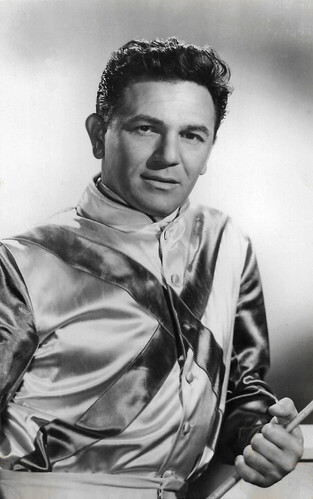
Spanish postcard by Soberanas. John Garfield in Under My Skin (Jean Negulesco, 1950).
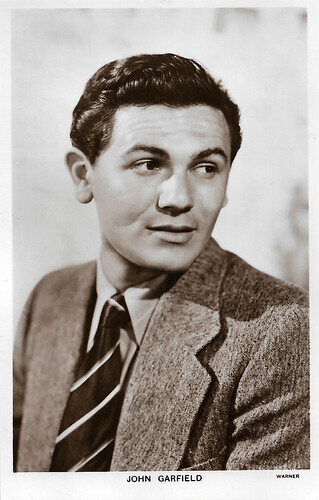
British postcard in the Picturegoer Series, London, no. 1262. Photo: Warner.
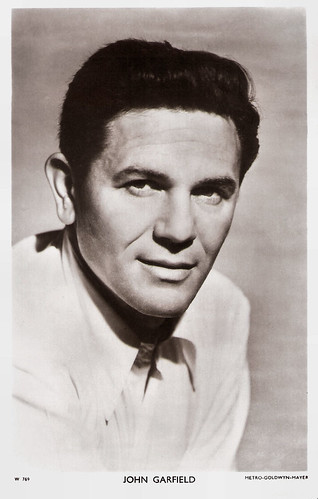
British postcard in the Picturegoer Series, no. W 769. Photo: Metro-Goldwyn-Mayer.
A name above the title
John Garfield was born Jacob Julius Garfinkle on the Lower East Side of New York City, to Hannah Basia (Margolis) and David Garfinkle, who were Jewish immigrants from Zhytomyr (now in Ukraine). Jules was raised by his father, a clothes presser and part-time cantor, after his mother's death in 1920, when he was 7. He grew up in the heart of the Yiddish Theatre District.
Jacob was sent to a special school for problem children, where he was introduced to boxing and drama. As a boy, he won a state-wide oratory contest sponsored by the New York Times with Benjamin Franklin as his subject. Garfield later won a scholarship to Maria Ouspenskaya's drama school. In 1932, he landed a non-paying job at Eva Le Gallienne's Civic Repertory, where he was recommended by his acting teachers Maria Ouspenskaya and Richard Boleslawski.
He changed his name to Jules Garfield and according to IMDb , he made his Broadway debut in that company's 'Counsellor-at-Law', written by Elmer Rice and starring Paul Muni . Wikipedia writes that this was actually his second Broadway appearance and that Garfield made his Broadway debut in 1932 in a play called 'Lost Boy', which ran for only two weeks.
Later, he joined the Group Theatre company, winning acclaim for his role as Ralph, the sensitive young son who pleads for "a chance to get to the first base" in 'Awake and Sing'. The play opened in February 1935, and Garfield was singled out by critic Brooks Atkinson for having a "splendid sense of character development." However, Garfield was passed over for the lead in 'Golden Boy', which had especially been written for him by author Clifford Odets. When the play was first produced by the Group Theatre in 1938, the powers that be decided Garfield wasn't 'ready' to play the role of the young violinist turned boxer. Luther Adler subsequently created the role.
Embittered, Garfield signed a contract with Warner Brothers, who changed his name to John Garfield. Because both Garfield and his wife did not want to 'go Hollywood,' he had a clause in his Warner contract that allowed him to perform in a legitimate play every year at his option. The couple also refused to own a home in Tinseltown. Garfield won enormous praise for his role as the cynical and tragic composer Mickey Borden in Four Daughters (Michael Curtiz, 1938), starring Claude Rains . For his part, he was nominated for the Oscar for Best Actor in a Supporting Role.
After the breakout success of Four Daughters, Warner Bros created a name-above-the-title vehicle for him, the crime film They Made Me a Criminal (Busby Berkeley, 1939). Garfield had already made a B movie called Blackwell's Island (William C. McGann, 1939). Not wanting their new star to appear in a low-budget film, Warners ordered an A movie upgrade by adding $100,000 to its budget and recalling director Michael Curtiz to shoot newly scripted scenes.
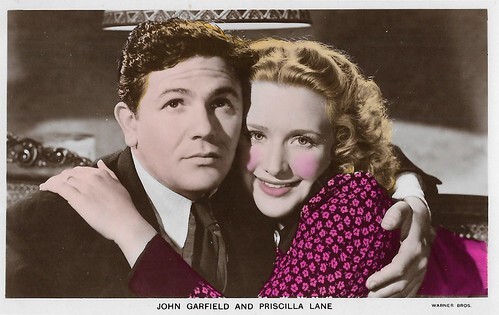
British postcard. Film Partner series, No. PC 303. John Garfield and Priscilla Lane in Four Daughters (Michael Curtiz, Warner Bros. 1938).

Belgian collectors card by Kwatta, Bois D'Haine, no. C. 174. Photo: M.G.M. John Garfield and Spencer Tracy in Tortilla Flat (Victor Fleming, 1942).

Spanish postcard, no. 4072. Photo: M.G.M. Hedy Lamarr and John Garfield in Tortilla Flat (Victor Fleming, 1942). The Spanish title is La vida es asi.
Brooding, rebellious roles
At the onset of World War II, John Garfield immediately attempted to enlist in the armed forces but was turned down because of his heart condition. Frustrated, he turned his energies to supporting the war effort. He and actress Bette Davis were the driving forces behind the opening of the Hollywood Canteen, a club offering food and entertainment for American servicemen.
He travelled overseas to help entertain the troops, made several bond-selling tours and starred in a string of popular, patriotic films like Air Force (Howard Hawks, 1943), Destination Tokyo (Delmer Daves, 1943) with Cary Grant , and Pride of the Marines (Delmer Faves, 1945) with Eleanor Parker. All were box office successes.
Throughout his film career, John Garfield, again and again, played brooding, rebellious roles despite his efforts to play varied parts. Garfield became one of Warner Bros' most suspended stars. He was suspended 11 times during his nine years at the studio. After the war, Garfield starred in a series of successful films such as the Film Noir The Postman Always Rings Twice (Tay Garnett, 1946) with Lana Turner , and the showbiz melodrama Humoresque (Jean Negulesco, 1946) with Joan Crawford .
When his Warner Bros. contract expired in 1946, he did not re-sign with the studio, opting to start his own independent production company instead. Garfield was one of the first Hollywood actors to do so. In the Best Picture Oscar-winning Gentleman's Agreement (Elia Kazan, 1947), Garfield took a featured but supporting, part because he believed deeply in the film's exposé of antisemitism in America.
In 1948, he was nominated for the Academy Award for Best Actor for his starring role in Body and Soul (Robert Rossen, 1947) with Lilli Palmer . That same year, Garfield returned to Broadway in the play 'Skipper Next to God'.
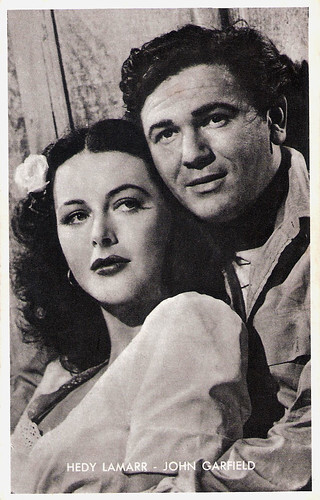
Belgian collectors card by Kwatta, Series C, no. 154 Photo: MGM. Hedy Lamarr and John Garfield in Tortilla Flat (Victor Fleming, 1942).
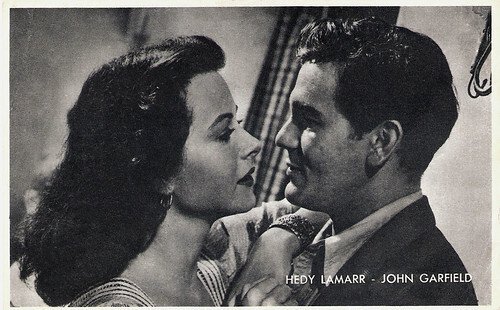
Belgian collectors card by Kwatta, Series C, no. 166. Photo: MGM. Hedy Lamarr and John Garfield in Tortilla Flat (Victor Fleming, 1942).
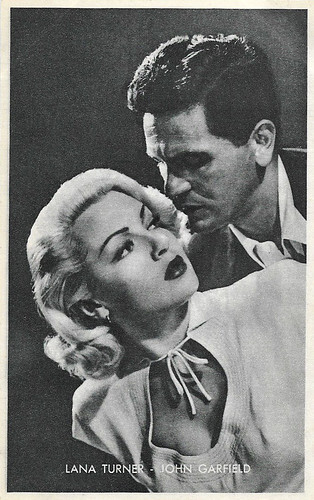
Belgian collectors card by Kwatta, Bois d'Haine, no. C. 173. Photo: Metro-Goldwyn-Mayer. Lana Turner and John Garfield in The Postman Always Rings Twice (Tay Garnett, 1946). Collection: Geoffrey Donaldson Institute.
Refusing to name names
Active in liberal political and social causes, John Garfield found himself embroiled in the Communist scare of the late 1940s. Blacklisted during the McCarthy era in the early 1950s for his left-wing political beliefs, he adamantly refused to "name names" in testimony before the House Un-American Activities Committee (HUAC) in April 1951.
In his only TV appearance, Garfield played Joe Bonaparte and Kim Stanley played Lorna Moon in a scene from Clifford Odets' 'Golden Boy' on Cavalcade of Stars: John Garfield, Kim Stanley, Paul Winchell & Jerry Mahoney (1950). With film work scarce because of the blacklist, Garfield returned to Broadway and starred in a 1951 or 1952 revival (the sources differ) of 'Golden Boy'. Garfield finally played the role which Odets had written for him and which was denied him years before at the Group Theater.
His final film was the Film Noir He Ran All the Way (John Berry, 1951), with Shelley Winters . On 21 May 1952, John Garfield was found dead of a heart attack in the apartment of a friend, former showgirl Iris Whitney. A week before he had separated from his wife, and hours before his death he completed a statement modifying his 1951 testimony about his Communist affiliations. A day earlier Clifford Odets had testified before HUAC and reaffirmed that Garfield had never been a member of the Communist Party.
Garfield was the fourth actor to die after being subjected to a HUAC investigation. The others were Mady Christians (at 59), J. Edward Bromberg (at 47) and Canada Lee (at 45). The official cause of his death was coronary thrombosis due to a blood clot blocking an artery in his heart. His funeral was mobbed by thousands of fans, the largest funeral attendance for an actor since Rudolph Valentino .
Garfield had been married to his childhood sweetheart Roberta Seidman, from 1935 till his death. They had three children, Katherine (1938-1945), actor David Garfield (1942-1995) and actress Julie Garfield (1946-). His six-year-old daughter Katharine died of an allergic reaction in 1945. He never got over the loss. John Garfield is buried at Westchester Hills Cemetery, Hastings-on-Hudson, New York.
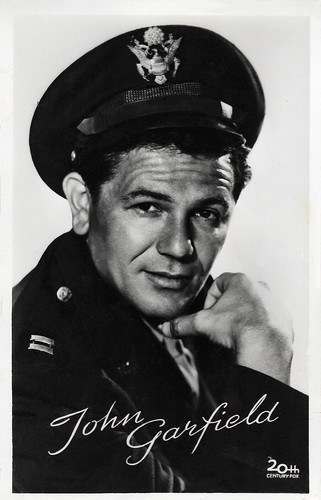
Dutch postcard. Photo: 20th Century Fox. John Garfield in Gentleman's Agreement (Elia Kazan, 1947).
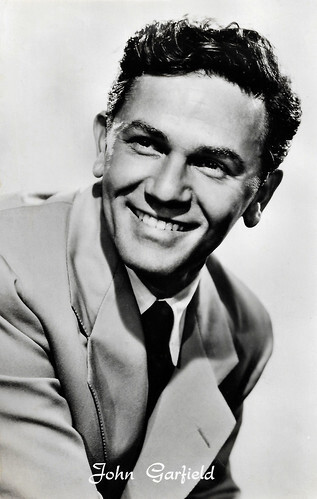
Belgian postcard. by Kores 'Carboplan'. Photo: Warner Bros.
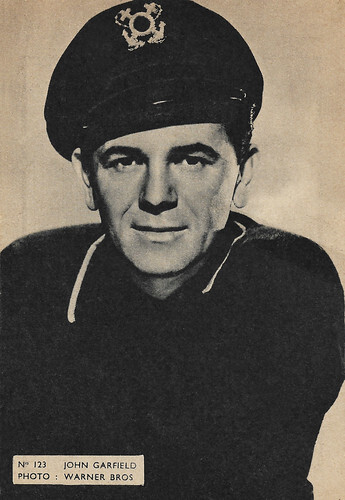
Belgian collectors card by Publesca for Le Cinéma Ritz, no. 123. Photo: Warner Bros. John Garfield in The Breaking Point (Michael Curtiz, 1950).
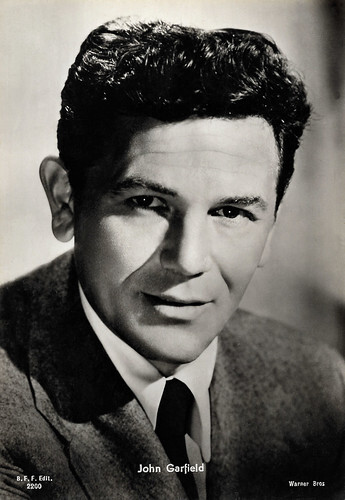
Italian postcard by B.F.F. Edit., no. 2200. Photo: Warner Bros.
Sources: (IMDb), Wikipedia and .

Spanish postcard by Soberanas. John Garfield in Under My Skin (Jean Negulesco, 1950).

British postcard in the Picturegoer Series, London, no. 1262. Photo: Warner.

British postcard in the Picturegoer Series, no. W 769. Photo: Metro-Goldwyn-Mayer.
A name above the title
John Garfield was born Jacob Julius Garfinkle on the Lower East Side of New York City, to Hannah Basia (Margolis) and David Garfinkle, who were Jewish immigrants from Zhytomyr (now in Ukraine). Jules was raised by his father, a clothes presser and part-time cantor, after his mother's death in 1920, when he was 7. He grew up in the heart of the Yiddish Theatre District.
Jacob was sent to a special school for problem children, where he was introduced to boxing and drama. As a boy, he won a state-wide oratory contest sponsored by the New York Times with Benjamin Franklin as his subject. Garfield later won a scholarship to Maria Ouspenskaya's drama school. In 1932, he landed a non-paying job at Eva Le Gallienne's Civic Repertory, where he was recommended by his acting teachers Maria Ouspenskaya and Richard Boleslawski.
He changed his name to Jules Garfield and according to IMDb , he made his Broadway debut in that company's 'Counsellor-at-Law', written by Elmer Rice and starring Paul Muni . Wikipedia writes that this was actually his second Broadway appearance and that Garfield made his Broadway debut in 1932 in a play called 'Lost Boy', which ran for only two weeks.
Later, he joined the Group Theatre company, winning acclaim for his role as Ralph, the sensitive young son who pleads for "a chance to get to the first base" in 'Awake and Sing'. The play opened in February 1935, and Garfield was singled out by critic Brooks Atkinson for having a "splendid sense of character development." However, Garfield was passed over for the lead in 'Golden Boy', which had especially been written for him by author Clifford Odets. When the play was first produced by the Group Theatre in 1938, the powers that be decided Garfield wasn't 'ready' to play the role of the young violinist turned boxer. Luther Adler subsequently created the role.
Embittered, Garfield signed a contract with Warner Brothers, who changed his name to John Garfield. Because both Garfield and his wife did not want to 'go Hollywood,' he had a clause in his Warner contract that allowed him to perform in a legitimate play every year at his option. The couple also refused to own a home in Tinseltown. Garfield won enormous praise for his role as the cynical and tragic composer Mickey Borden in Four Daughters (Michael Curtiz, 1938), starring Claude Rains . For his part, he was nominated for the Oscar for Best Actor in a Supporting Role.
After the breakout success of Four Daughters, Warner Bros created a name-above-the-title vehicle for him, the crime film They Made Me a Criminal (Busby Berkeley, 1939). Garfield had already made a B movie called Blackwell's Island (William C. McGann, 1939). Not wanting their new star to appear in a low-budget film, Warners ordered an A movie upgrade by adding $100,000 to its budget and recalling director Michael Curtiz to shoot newly scripted scenes.

British postcard. Film Partner series, No. PC 303. John Garfield and Priscilla Lane in Four Daughters (Michael Curtiz, Warner Bros. 1938).

Belgian collectors card by Kwatta, Bois D'Haine, no. C. 174. Photo: M.G.M. John Garfield and Spencer Tracy in Tortilla Flat (Victor Fleming, 1942).

Spanish postcard, no. 4072. Photo: M.G.M. Hedy Lamarr and John Garfield in Tortilla Flat (Victor Fleming, 1942). The Spanish title is La vida es asi.
Brooding, rebellious roles
At the onset of World War II, John Garfield immediately attempted to enlist in the armed forces but was turned down because of his heart condition. Frustrated, he turned his energies to supporting the war effort. He and actress Bette Davis were the driving forces behind the opening of the Hollywood Canteen, a club offering food and entertainment for American servicemen.
He travelled overseas to help entertain the troops, made several bond-selling tours and starred in a string of popular, patriotic films like Air Force (Howard Hawks, 1943), Destination Tokyo (Delmer Daves, 1943) with Cary Grant , and Pride of the Marines (Delmer Faves, 1945) with Eleanor Parker. All were box office successes.
Throughout his film career, John Garfield, again and again, played brooding, rebellious roles despite his efforts to play varied parts. Garfield became one of Warner Bros' most suspended stars. He was suspended 11 times during his nine years at the studio. After the war, Garfield starred in a series of successful films such as the Film Noir The Postman Always Rings Twice (Tay Garnett, 1946) with Lana Turner , and the showbiz melodrama Humoresque (Jean Negulesco, 1946) with Joan Crawford .
When his Warner Bros. contract expired in 1946, he did not re-sign with the studio, opting to start his own independent production company instead. Garfield was one of the first Hollywood actors to do so. In the Best Picture Oscar-winning Gentleman's Agreement (Elia Kazan, 1947), Garfield took a featured but supporting, part because he believed deeply in the film's exposé of antisemitism in America.
In 1948, he was nominated for the Academy Award for Best Actor for his starring role in Body and Soul (Robert Rossen, 1947) with Lilli Palmer . That same year, Garfield returned to Broadway in the play 'Skipper Next to God'.

Belgian collectors card by Kwatta, Series C, no. 154 Photo: MGM. Hedy Lamarr and John Garfield in Tortilla Flat (Victor Fleming, 1942).

Belgian collectors card by Kwatta, Series C, no. 166. Photo: MGM. Hedy Lamarr and John Garfield in Tortilla Flat (Victor Fleming, 1942).

Belgian collectors card by Kwatta, Bois d'Haine, no. C. 173. Photo: Metro-Goldwyn-Mayer. Lana Turner and John Garfield in The Postman Always Rings Twice (Tay Garnett, 1946). Collection: Geoffrey Donaldson Institute.
Refusing to name names
Active in liberal political and social causes, John Garfield found himself embroiled in the Communist scare of the late 1940s. Blacklisted during the McCarthy era in the early 1950s for his left-wing political beliefs, he adamantly refused to "name names" in testimony before the House Un-American Activities Committee (HUAC) in April 1951.
In his only TV appearance, Garfield played Joe Bonaparte and Kim Stanley played Lorna Moon in a scene from Clifford Odets' 'Golden Boy' on Cavalcade of Stars: John Garfield, Kim Stanley, Paul Winchell & Jerry Mahoney (1950). With film work scarce because of the blacklist, Garfield returned to Broadway and starred in a 1951 or 1952 revival (the sources differ) of 'Golden Boy'. Garfield finally played the role which Odets had written for him and which was denied him years before at the Group Theater.
His final film was the Film Noir He Ran All the Way (John Berry, 1951), with Shelley Winters . On 21 May 1952, John Garfield was found dead of a heart attack in the apartment of a friend, former showgirl Iris Whitney. A week before he had separated from his wife, and hours before his death he completed a statement modifying his 1951 testimony about his Communist affiliations. A day earlier Clifford Odets had testified before HUAC and reaffirmed that Garfield had never been a member of the Communist Party.
Garfield was the fourth actor to die after being subjected to a HUAC investigation. The others were Mady Christians (at 59), J. Edward Bromberg (at 47) and Canada Lee (at 45). The official cause of his death was coronary thrombosis due to a blood clot blocking an artery in his heart. His funeral was mobbed by thousands of fans, the largest funeral attendance for an actor since Rudolph Valentino .
Garfield had been married to his childhood sweetheart Roberta Seidman, from 1935 till his death. They had three children, Katherine (1938-1945), actor David Garfield (1942-1995) and actress Julie Garfield (1946-). His six-year-old daughter Katharine died of an allergic reaction in 1945. He never got over the loss. John Garfield is buried at Westchester Hills Cemetery, Hastings-on-Hudson, New York.

Dutch postcard. Photo: 20th Century Fox. John Garfield in Gentleman's Agreement (Elia Kazan, 1947).

Belgian postcard. by Kores 'Carboplan'. Photo: Warner Bros.

Belgian collectors card by Publesca for Le Cinéma Ritz, no. 123. Photo: Warner Bros. John Garfield in The Breaking Point (Michael Curtiz, 1950).

Italian postcard by B.F.F. Edit., no. 2200. Photo: Warner Bros.
Sources: (IMDb), Wikipedia and .
Published on August 11, 2022 22:00
August 10, 2022
Alien (1979)
"In space, no one can hear you scream" is the tagline of the Sci-Fi Horror classic Alien (Ridley Scott, 1979). A close encounter of the third kind becomes a Jaws-style nightmare when an alien invades a spacecraft. Alien stands as one of the more thought-provoking, yet utterly terrifying horror films ever. Sigourney Weaver is amazing as Ellen Ripley, who became an iconic character in film history. The film won an Oscar for special effects, including the alien designed by Swiss artist H.R. Giger.
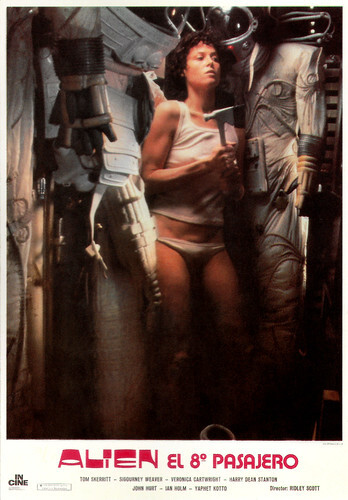
Spanish postcard by Editions Mercuri, no. 465. Photo: Sigourney Weaver in Alien (Ridley Scott, 1979). Caption: Alien el 8 pasajero.
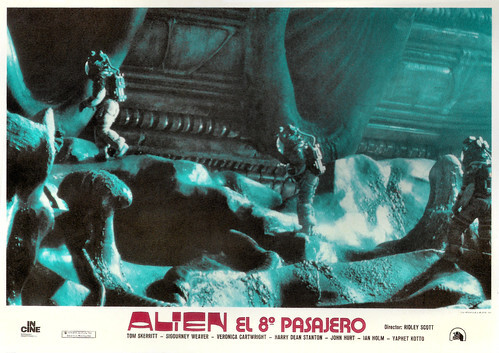
French postcard by Editions Mercuri, no. 464. Image: Spanish lobby card for Alien (Ridley Scott, 1979). The Spanish title is 'Alien, el octavo pasajero'.
What should the monster look like
It is the year 2122. The U.S.C.S. Nostromo (Italian for "mate"), a commercial cargo spacecraft, is flying to Earth with several million tonnes of ore on board. The ship is manned by seven people and a sophisticated computer, which the crew call "Mother".
The crew members are the men Dallas, Ash, Kane, Parker and Brett and the women Ripley and Lambert. The crew is woken up from hibernation by the ship's Mother computer to answer a distress signal from a nearby planet. Capt. Dallas's (Tom Skerritt) rescue team discovers a bizarre pod field, but things get even stranger when a face-hugging creature bursts out of a pod and attaches itself to Kane (John Hurt).
Over the objections of Ripley ( Sigourney Weaver ), science officer Ash (Ian Holm) lets Kane back on the ship. The acid-blooded incubus detaches itself from an apparently recovered Kane, but an alien erupts from Kane's stomach and escapes. The alien starts stalking the humans, pitting Dallas and his crew (and cat) against a malevolent killing machine that also has a protector in the nefarious Company.
While still a student at the University of Southern California, scriptwriter Dan O'Bannon had teamed up with director John Carpenter to make a comic science fiction film called Dark Star (John Carpenter, 1974). His experience making this film gave Bannon the idea of making a similar film, but with a horror theme instead of a comedy.
A few years later, he began writing a screenplay around this idea. Around the same time, Ronald Shusett began working on a screenplay that would eventually become Total Recall (Paul Verhoeven, 1990). He contacted O'Bannon after seeing Dark Star, after which the two decided to work together on Alien. However, O'Bannon had not yet thought about what the monster should look like.

French postcard by Editions Mercuri, no. 466. Image: Spanish lobby card for Alien (Ridley Scott, 1979). The Spanish title is 'Alien, el octavo pasajero'.
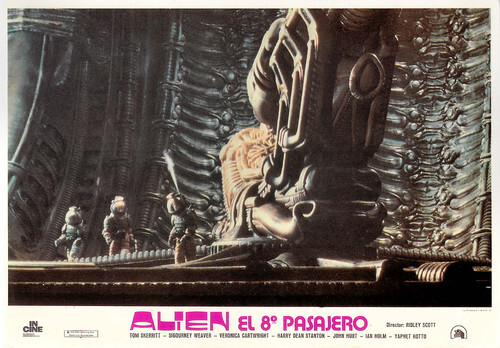
French postcard by Editions Mercuri, no. 467. Image: Spanish lobby card for Alien (Ridley Scott, 1979). The Spanish title is 'Alien, el octavo pasajero'.
Ripley's forceful horror heroine
Swiss artist H.R. Giger's alien design and Carlo Rambaldi's visual effects for Alien (Ridley Scott, 1979) creepily meld technology with corporeality, creating a claustrophobic environment that is coldly mechanical yet horribly anthropomorphized, like the metallic monster itself. Director Ridley Scott keeps the alien out of full view, hiding it in the dark or camouflaging it in the workings of the Nostromo.
Lucia Bozzola at AllMovie : "Signs of '70s cultural upheaval permeate Alien's future world, from the relationship between corporate capitalism and rapacious monstrosity to the heterogeneous crew and Ripley's forceful horror heroine. However, the intense frights and gross-outs are credited with making Alien one of the biggest hits of 1979 (it premiered on the two-year anniversary of Star Wars); Giger, Rambaldi, et al. won the Oscar for Best Visual Effects."
Alien went on to spawn some genre-bending sequels: the actioner Aliens (James Cameron, 1986), the dark prison drama Alien 3 (David Fincher, 1992), and the exotically grotesque Alien Resurrection (Jean-Pierre Jeunet, 1997). In 2003, a director's cut of Alien (Ridley Scott, 1979) was released in cinemas, with some additional scenes. The franchise now counts seven films.
Roger Ebert: "Certainly the character of Ripley, played by Sigourney Weaver , would have appealed to readers in the Golden Age of Science Fiction. She has little interest in the romance of finding the alien, and still less in her employer's orders that it be brought back home as a potential weapon. After she sees what it can do, her response to "Special Order 24" ("Return alien lifeform, all other priorities rescinded") is succinct: "How do we kill it?" Her implacable hatred for the alien is the common thread running through all three "Alien" sequels, which have gradually descended in quality but retained their motivating obsession."
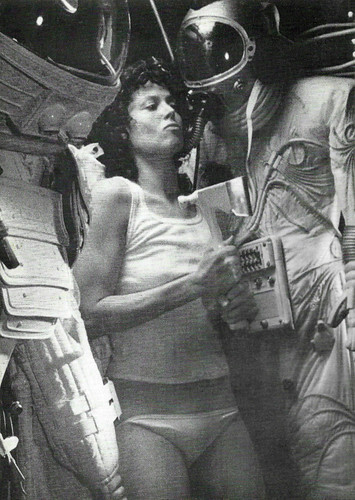
British postcard in the Mini Series by Lilliput Production, London, no. 505. Sigourney Weaver in Alien (Ridley Scott, 1979).
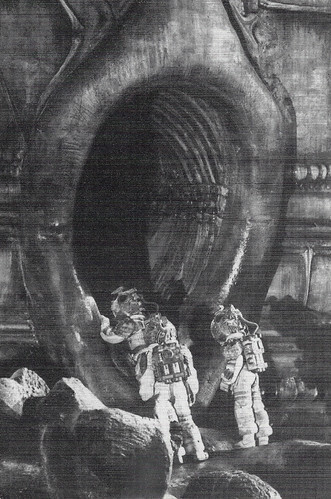
Belgian postcard by Raider Bounty / Joepie. Photo: publicity still for Alien (Ridley Scott, 1979).
Sources: Roger Ebert (RogerEbert.com), Lucia Bozzola (AllMovie), Wikipedia (Dutch), and IMDb.

Spanish postcard by Editions Mercuri, no. 465. Photo: Sigourney Weaver in Alien (Ridley Scott, 1979). Caption: Alien el 8 pasajero.

French postcard by Editions Mercuri, no. 464. Image: Spanish lobby card for Alien (Ridley Scott, 1979). The Spanish title is 'Alien, el octavo pasajero'.
What should the monster look like
It is the year 2122. The U.S.C.S. Nostromo (Italian for "mate"), a commercial cargo spacecraft, is flying to Earth with several million tonnes of ore on board. The ship is manned by seven people and a sophisticated computer, which the crew call "Mother".
The crew members are the men Dallas, Ash, Kane, Parker and Brett and the women Ripley and Lambert. The crew is woken up from hibernation by the ship's Mother computer to answer a distress signal from a nearby planet. Capt. Dallas's (Tom Skerritt) rescue team discovers a bizarre pod field, but things get even stranger when a face-hugging creature bursts out of a pod and attaches itself to Kane (John Hurt).
Over the objections of Ripley ( Sigourney Weaver ), science officer Ash (Ian Holm) lets Kane back on the ship. The acid-blooded incubus detaches itself from an apparently recovered Kane, but an alien erupts from Kane's stomach and escapes. The alien starts stalking the humans, pitting Dallas and his crew (and cat) against a malevolent killing machine that also has a protector in the nefarious Company.
While still a student at the University of Southern California, scriptwriter Dan O'Bannon had teamed up with director John Carpenter to make a comic science fiction film called Dark Star (John Carpenter, 1974). His experience making this film gave Bannon the idea of making a similar film, but with a horror theme instead of a comedy.
A few years later, he began writing a screenplay around this idea. Around the same time, Ronald Shusett began working on a screenplay that would eventually become Total Recall (Paul Verhoeven, 1990). He contacted O'Bannon after seeing Dark Star, after which the two decided to work together on Alien. However, O'Bannon had not yet thought about what the monster should look like.

French postcard by Editions Mercuri, no. 466. Image: Spanish lobby card for Alien (Ridley Scott, 1979). The Spanish title is 'Alien, el octavo pasajero'.

French postcard by Editions Mercuri, no. 467. Image: Spanish lobby card for Alien (Ridley Scott, 1979). The Spanish title is 'Alien, el octavo pasajero'.
Ripley's forceful horror heroine
Swiss artist H.R. Giger's alien design and Carlo Rambaldi's visual effects for Alien (Ridley Scott, 1979) creepily meld technology with corporeality, creating a claustrophobic environment that is coldly mechanical yet horribly anthropomorphized, like the metallic monster itself. Director Ridley Scott keeps the alien out of full view, hiding it in the dark or camouflaging it in the workings of the Nostromo.
Lucia Bozzola at AllMovie : "Signs of '70s cultural upheaval permeate Alien's future world, from the relationship between corporate capitalism and rapacious monstrosity to the heterogeneous crew and Ripley's forceful horror heroine. However, the intense frights and gross-outs are credited with making Alien one of the biggest hits of 1979 (it premiered on the two-year anniversary of Star Wars); Giger, Rambaldi, et al. won the Oscar for Best Visual Effects."
Alien went on to spawn some genre-bending sequels: the actioner Aliens (James Cameron, 1986), the dark prison drama Alien 3 (David Fincher, 1992), and the exotically grotesque Alien Resurrection (Jean-Pierre Jeunet, 1997). In 2003, a director's cut of Alien (Ridley Scott, 1979) was released in cinemas, with some additional scenes. The franchise now counts seven films.
Roger Ebert: "Certainly the character of Ripley, played by Sigourney Weaver , would have appealed to readers in the Golden Age of Science Fiction. She has little interest in the romance of finding the alien, and still less in her employer's orders that it be brought back home as a potential weapon. After she sees what it can do, her response to "Special Order 24" ("Return alien lifeform, all other priorities rescinded") is succinct: "How do we kill it?" Her implacable hatred for the alien is the common thread running through all three "Alien" sequels, which have gradually descended in quality but retained their motivating obsession."

British postcard in the Mini Series by Lilliput Production, London, no. 505. Sigourney Weaver in Alien (Ridley Scott, 1979).

Belgian postcard by Raider Bounty / Joepie. Photo: publicity still for Alien (Ridley Scott, 1979).
Sources: Roger Ebert (RogerEbert.com), Lucia Bozzola (AllMovie), Wikipedia (Dutch), and IMDb.
Published on August 10, 2022 22:00
August 9, 2022
Olivia Newton-John (1948-2022)
On 8 August 2022, British-Australian singer and actress Olivia Newton-John (1948) passed away at the age of 73. She was best known for the musical film Grease (1978). Olivia had been suffering from breast cancer for some time. She died at her home in California in the presence of her family and friends.
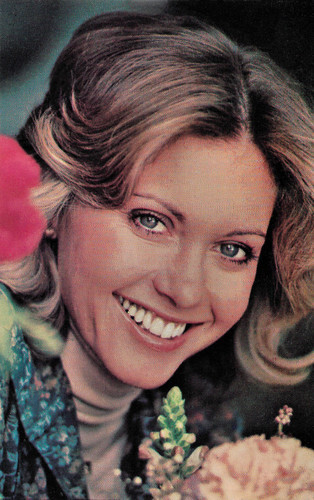
American postcard by Coral-Lee, Rancho Cordova, CA, no. CL/Personality #2 (C31 766), 1977. Photo: Halstead / Contact.
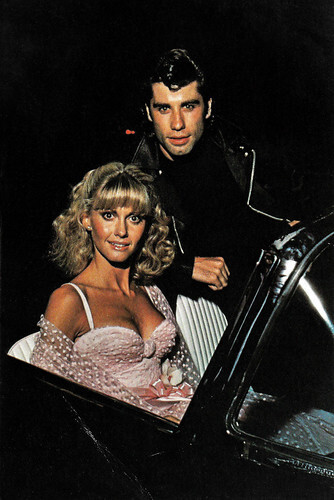
French postcard by Star, Paris, in the Collection John Travolta. John Travolta and Olivia Newton-John in Grease (Randal Kleiser, 1978).
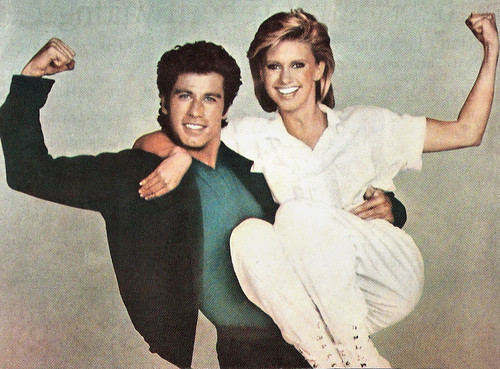
Romanian postcard by Casa Filmului Acin, no. 53190. John Travolta and Olivia Newton-John in Two of a Kind (John Herzfeld, 1983).
You're the One That I Want
Olivia Newton-John was born in 1948 in the British city of Cambridge. She was a granddaughter of Max Born (1882-1970), winner of the Nobel Prize for Physics in 1954. With her family, she moved to Australia at a young age.
She scored her first hit as a singer in the early 1970s and in 1974 entered the Eurovision Song Contest on behalf of the United Kingdom. She finished with her song 'Long live love' in fourth place. It was the year ABBA won with 'Waterloo'.
Shortly afterwards, she moved to the US, where she also had a successful singing career, with mainly country songs. She had five number-one hits and won four Grammy Awards with such songs as 'If You Love Me, Let Me Know' (1974), 'I Honestly Love You' (1974), 'Have You Never Been Mellow' (1975), and 'Physical' (1981).
In 1978, Olivia Newton-John starred in the musical film Grease (Randal Kleiser, 1978). Grease was her big break as an actress. She was asked to play the role of the goody-goody Sandy Olsson when she met producer Allan Carr at a dinner. At first, she was afraid that she was already too old (she was 29 when filming began) to pass for a high school student, but after a screen test with her co-star John Travolta , she decided to accept the role.
Grease became the biggest box-office success of 1978. The soundtrack remains one of the most successful in history. It features two major hit duets with co-star John Travolta : 'You're the One That I Want' – which ranks as one of the best-selling singles of all time – and 'Summer Nights'.
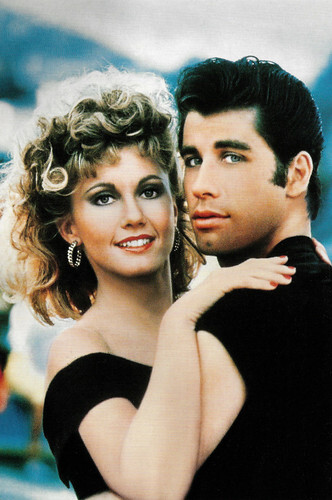
Australian postcard for Goma Cinema by Avant Card, 2012. John Travolta and Olivia Newton-John in Grease (Randal Kleiser, 1978).

Dutch postcard, no. AX 7377. John Travolta and Olivia Newton-John in Grease (Randal Kleiser, 1978).

Dutch postcard, no. AX 7377. John Travolta and Olivia Newton-John in Grease (Randal Kleiser, 1978).
Magic
In 1980, Olivia Newton-John scored again with the songs 'Magic' and 'Xanadu' (with Electric Light Orchestra) from the film Xanadu (Robert Greenwald, 1980). Her later films were less successful.
Newton-John was first diagnosed with breast cancer in 1992. After treatment, she recovered. She later recorded the album 'Gaia: One Woman's Journey' about this period. It was the first album for which she wrote both the music and lyrics herself. Since then, she has also dedicated herself to more research into (breast) cancer.
In 2013, Newton-John was treated for a tumour in her shoulder. She healed, but five years ago the disease returned and metastasised to her lower back. In 2019, Newton-John was knighted by Britain's Queen Elizabeth, in part for her contribution to cancer research.
Newton-John was married to actor Matt Lattanzi between 1984 and 1995. The actress Chloe Rose Lattanzi (1986) is the daughter of this marriage. From 1996-2004, Newton-John had a relationship with cameraman Patrick McDermott, who disappeared in 2005 during a fishing trip. Since 2008, she was married to businessman John Easterling.
Olivia Newton-John has sold an estimated 120 million records worldwide, making her one of the best-selling music artists of all time.

Dutch postcard, no. AG 1009. John Travolta and Olivia Newton-John in Grease (Randal Kleiser, 1978).

Dutch postcard. John Travolta and Olivia Newton-John in Grease (Randal Kleiser, 1978).

Dutch postcard. John Travolta and Olivia Newton-John in Grease (Randal Kleiser, 1978).
Sources: Nos.nl (Dutch), Wikipedia (English and Dutch) and .

American postcard by Coral-Lee, Rancho Cordova, CA, no. CL/Personality #2 (C31 766), 1977. Photo: Halstead / Contact.

French postcard by Star, Paris, in the Collection John Travolta. John Travolta and Olivia Newton-John in Grease (Randal Kleiser, 1978).

Romanian postcard by Casa Filmului Acin, no. 53190. John Travolta and Olivia Newton-John in Two of a Kind (John Herzfeld, 1983).
You're the One That I Want
Olivia Newton-John was born in 1948 in the British city of Cambridge. She was a granddaughter of Max Born (1882-1970), winner of the Nobel Prize for Physics in 1954. With her family, she moved to Australia at a young age.
She scored her first hit as a singer in the early 1970s and in 1974 entered the Eurovision Song Contest on behalf of the United Kingdom. She finished with her song 'Long live love' in fourth place. It was the year ABBA won with 'Waterloo'.
Shortly afterwards, she moved to the US, where she also had a successful singing career, with mainly country songs. She had five number-one hits and won four Grammy Awards with such songs as 'If You Love Me, Let Me Know' (1974), 'I Honestly Love You' (1974), 'Have You Never Been Mellow' (1975), and 'Physical' (1981).
In 1978, Olivia Newton-John starred in the musical film Grease (Randal Kleiser, 1978). Grease was her big break as an actress. She was asked to play the role of the goody-goody Sandy Olsson when she met producer Allan Carr at a dinner. At first, she was afraid that she was already too old (she was 29 when filming began) to pass for a high school student, but after a screen test with her co-star John Travolta , she decided to accept the role.
Grease became the biggest box-office success of 1978. The soundtrack remains one of the most successful in history. It features two major hit duets with co-star John Travolta : 'You're the One That I Want' – which ranks as one of the best-selling singles of all time – and 'Summer Nights'.

Australian postcard for Goma Cinema by Avant Card, 2012. John Travolta and Olivia Newton-John in Grease (Randal Kleiser, 1978).

Dutch postcard, no. AX 7377. John Travolta and Olivia Newton-John in Grease (Randal Kleiser, 1978).

Dutch postcard, no. AX 7377. John Travolta and Olivia Newton-John in Grease (Randal Kleiser, 1978).
Magic
In 1980, Olivia Newton-John scored again with the songs 'Magic' and 'Xanadu' (with Electric Light Orchestra) from the film Xanadu (Robert Greenwald, 1980). Her later films were less successful.
Newton-John was first diagnosed with breast cancer in 1992. After treatment, she recovered. She later recorded the album 'Gaia: One Woman's Journey' about this period. It was the first album for which she wrote both the music and lyrics herself. Since then, she has also dedicated herself to more research into (breast) cancer.
In 2013, Newton-John was treated for a tumour in her shoulder. She healed, but five years ago the disease returned and metastasised to her lower back. In 2019, Newton-John was knighted by Britain's Queen Elizabeth, in part for her contribution to cancer research.
Newton-John was married to actor Matt Lattanzi between 1984 and 1995. The actress Chloe Rose Lattanzi (1986) is the daughter of this marriage. From 1996-2004, Newton-John had a relationship with cameraman Patrick McDermott, who disappeared in 2005 during a fishing trip. Since 2008, she was married to businessman John Easterling.
Olivia Newton-John has sold an estimated 120 million records worldwide, making her one of the best-selling music artists of all time.

Dutch postcard, no. AG 1009. John Travolta and Olivia Newton-John in Grease (Randal Kleiser, 1978).

Dutch postcard. John Travolta and Olivia Newton-John in Grease (Randal Kleiser, 1978).

Dutch postcard. John Travolta and Olivia Newton-John in Grease (Randal Kleiser, 1978).
Sources: Nos.nl (Dutch), Wikipedia (English and Dutch) and .
Published on August 09, 2022 22:00
August 8, 2022
Lili Berky
In our series on the silent Hungarian cinema, EFSP presents Lili Berky (1886–1958), also known as Lilli Berky and Lili Berki. The Hungarian stage and screen actress starred in over 30 Hungarian silent films between 1913 and the late 1920s. She also played in an equal amount of Hungarian sound films, mainly in the 1930s and early 1940s. In 1917 she became the wife of actor and comedian Gyula Gózon. They often performed together.
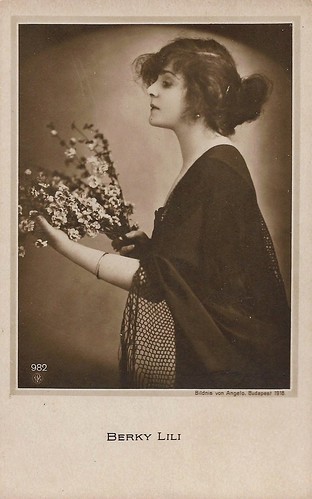
German postcard by NPG, no. 982. Photo: Angelo, Budapest, 1918.
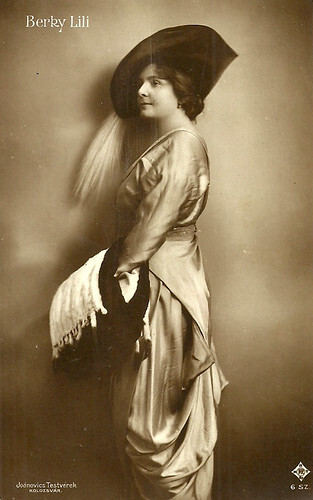
Hungarian postcard by Magyar Rotophot Tarsáság, Budapest, 6 SZ. Photo: Joanovics brothers, Koloszvar, Hungary (now Cluj, Romania).
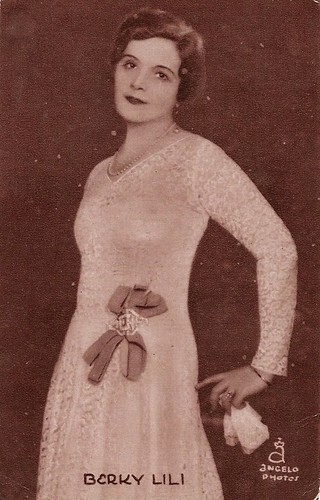
Hungarian postcard by the magazine Színházi Élet (Theatre Life). Photo: Angelo photos.
One of the first Hungarian films to be exported to other countries
Lili Berky was born Amália Terézia Berky in Gyõrr, Austria-Hungary, in 1886. She was the daughter of theatre director Ferenc Berky (Bauer) and Amália Tóth of Aszod. Lily already acted at the age of 8 and in 1903 she graduated from the Hungarian Royal Dramatic School of Art.
Berky had an intense career as an actress and singer from then on, first at the King's Theatre in 1905-1906, then the Cluj theatre in 1906-1911, the Nepopera (People's Opera) in 1911-1913, in 1915-1919 the Cluj theatre again. And so on and on, until the 1950s, she shifted from one regime to another, often also shifting theatre companies, and continuing to play until her death.
Berky's first big film success was the drama Sárga csikó/The Yellow Foal (Félix Vanyl, 1913) starring Lili Berky, Gyula Nagy and Mihaly Varkonyi (the later Victor Varconi). It was co-produced by the French Pathé and local producer Jenő Janovics. The film was exported to nearly forty countries worldwide.
On the back of the film's massive success, Janovics built his Corvin Film company into a leading studio, attracting talented Hungarian actors, writers and technicians away from the capital Budapest to work for him in Kolozsvár (Cluj).
Berky starred in Michael Kertesz's (Michael Curtiz's) A tolonc/The Exile (1914), opposite Victor Varconi. Also memorable is the silent drama Fehér éjszakák/White Nights (Alexander Korda, 1916), starring Lili Berky, Kálmán Körmendy and György Kürthy. It was based on the play 'Fédora' by Victorien Sardou and is sometimes known by the alternative title 'Fédora'.
Fehér éjszakák/White Nights was Alexander Korda's first film for the Corvin Film studio. It was a major success and was one of the first Hungarian films to be exported to other countries. Korda would continue to direct Berky in various Hungarian films such as Vergödö szívek/Struggling Hearts (Alexander Korda, 1916), Mesék az írógépröl/Tales of the Typewriter (Alexander Korda, 1916), and Mágnás Miska/Miska the Magnate (Alexander Korda, 1916), based on a popular operetta.
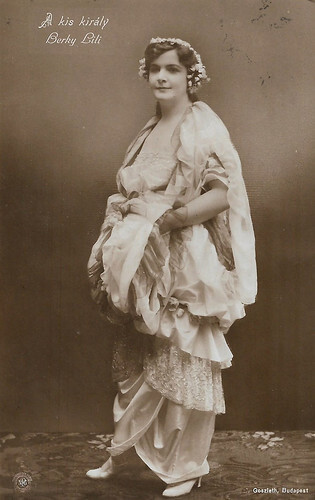
Hungarian postcard by NPG (Neue Photographische Gesellschaft). Photo: Istvan Goszleth, Budapest. Lili Berky in the operetta 'A kis kiraly/Der kleine König' by Emmerich Kalman. The operetta premiered in Vienna in 1912.
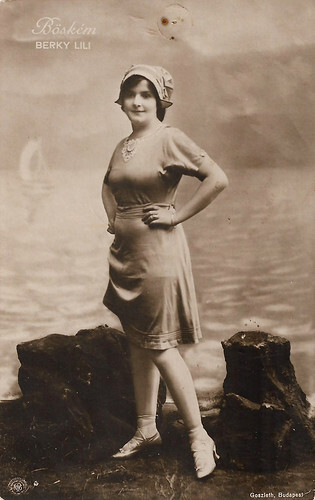
Hungarian postcard by NPG (Neue Photographische Gesellschaft). Photo: Istvan Goszleth, Budapest. Lili Berky in the operetta 'Böském' (1914) by Béla Tompa.
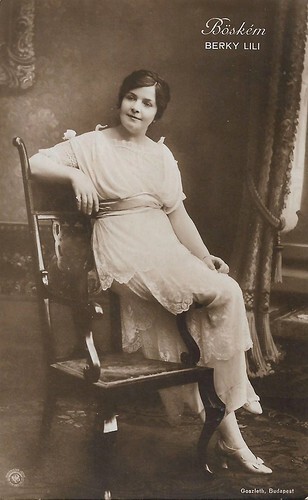
Hungarian postcard by NPG (Neue Photographische Gesellschaft). Photo: Istvan Goszleth, Budapest. Lili Berky in the operetta 'Böském' (1914) by Béla Tompa.
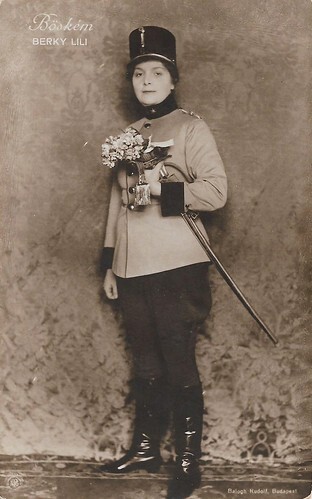
Hungarian postcard by NPG (Neue Photographische Gesellschaft). Photo: Rudolf Balogh, Budapest. Lili Berky in the operetta 'Böském' (1914) by Béla Tompa.
Hiding because of the anti-Jewish laws
In the 1930s, Lili Berky would often perform in the romantic comedies by Béla Gaál. These films included the comedy Az új rokon/The New Relative (Béla Gaál, 1934) with Zita Perczel, and the drama Ida regénye/Romance of Ida (Steve Sekely, 1934), starring Gábor Rajnay, Irén Ágay and Pál Jávor .
Berky played another supporting part in the comedy Ez a villa eladó/Villa for Sale (Géza von Cziffra, 1935) starring Ernő Verebes , Ida Turay and Gyula Kabos. After he goes away on holiday, a wealthy man's servant accidentally puts his villa up for sale. She played the female lead in the drama Párbaj semmiért/Duel for Nothing (Emil Martonffy, 1940) starring Gyula Csortos.
She played in more than 30 Hungarian sound films, mainly in the 1930s and early 1940s. During the war, her husband, Hungarian actor and comedian Gyula Gózon, had to hide because of the anti-Jewish laws, while she continued to act. Yet, Gózon managed to survive all the changes in regimes.
After the war Lily Berky had minor parts in Hungarian film dramas, of which two were presented in Cannes: A Tanítónő/The teacher (Márton Keleti, 1945) and Különös házasság/A strange marriage (Márton Keleti, 1951) with Miklos Gabor. Her last stage role was as the Archduchess in Ferenc Molnár's 'The Swan', and her final film part was in Az élet hídja/The Bridge of Life (Márton Keleti, 1956).
Lili Berky died in Budapest, in 1958, at the age of 71. She was the wife of the Kossuth Prize-winning actor Gyula Gózon.
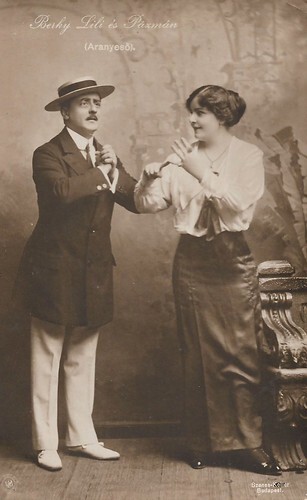
Hungarian postcard by NPG (Neue Photographische Gesellschaft). Photo: Szenes-Koller, Budapest. Lili Berky and Ferenc Pázmán in 'Aranyesö'. 'Aranyesö' (lit. Golden Rain) was the title of an operetta composed by Béla Zerkovitz and with a libretto by Adolf Mérei and Izor Béldia, first staged in 1913. Lily Berky performed together with singer/comedian Horthy.
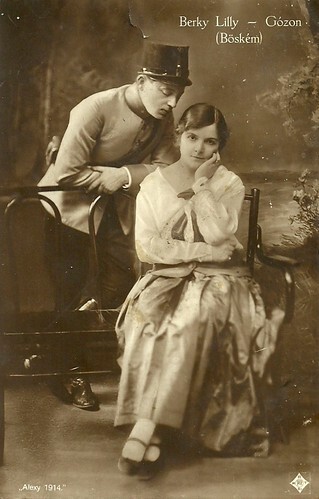
Hungarian postcard by Magyar Rotophot Tarsáság, Budapest. Photo: Alexy, 1914. Lili Berky and Gyula Gózon in the operetta 'Böském' (1914) by Béla Tompa. In the same year, the two stage actors also acted in the film version of the play, directed by Aladár Fodor for the company Kino-Report.
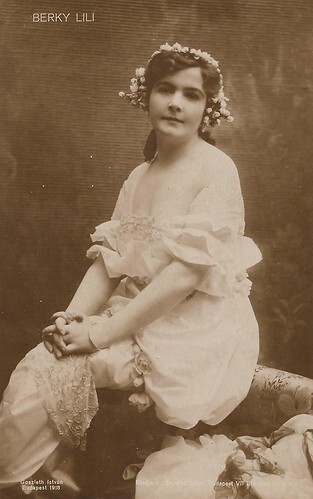
Hungarian postcard by the magazine Színházi Élet (Theatre Life). Photo: Istvan Goszleth, 1918.
Sources: Wikipedia (English, French and Hungarian) and .

German postcard by NPG, no. 982. Photo: Angelo, Budapest, 1918.

Hungarian postcard by Magyar Rotophot Tarsáság, Budapest, 6 SZ. Photo: Joanovics brothers, Koloszvar, Hungary (now Cluj, Romania).

Hungarian postcard by the magazine Színházi Élet (Theatre Life). Photo: Angelo photos.
One of the first Hungarian films to be exported to other countries
Lili Berky was born Amália Terézia Berky in Gyõrr, Austria-Hungary, in 1886. She was the daughter of theatre director Ferenc Berky (Bauer) and Amália Tóth of Aszod. Lily already acted at the age of 8 and in 1903 she graduated from the Hungarian Royal Dramatic School of Art.
Berky had an intense career as an actress and singer from then on, first at the King's Theatre in 1905-1906, then the Cluj theatre in 1906-1911, the Nepopera (People's Opera) in 1911-1913, in 1915-1919 the Cluj theatre again. And so on and on, until the 1950s, she shifted from one regime to another, often also shifting theatre companies, and continuing to play until her death.
Berky's first big film success was the drama Sárga csikó/The Yellow Foal (Félix Vanyl, 1913) starring Lili Berky, Gyula Nagy and Mihaly Varkonyi (the later Victor Varconi). It was co-produced by the French Pathé and local producer Jenő Janovics. The film was exported to nearly forty countries worldwide.
On the back of the film's massive success, Janovics built his Corvin Film company into a leading studio, attracting talented Hungarian actors, writers and technicians away from the capital Budapest to work for him in Kolozsvár (Cluj).
Berky starred in Michael Kertesz's (Michael Curtiz's) A tolonc/The Exile (1914), opposite Victor Varconi. Also memorable is the silent drama Fehér éjszakák/White Nights (Alexander Korda, 1916), starring Lili Berky, Kálmán Körmendy and György Kürthy. It was based on the play 'Fédora' by Victorien Sardou and is sometimes known by the alternative title 'Fédora'.
Fehér éjszakák/White Nights was Alexander Korda's first film for the Corvin Film studio. It was a major success and was one of the first Hungarian films to be exported to other countries. Korda would continue to direct Berky in various Hungarian films such as Vergödö szívek/Struggling Hearts (Alexander Korda, 1916), Mesék az írógépröl/Tales of the Typewriter (Alexander Korda, 1916), and Mágnás Miska/Miska the Magnate (Alexander Korda, 1916), based on a popular operetta.

Hungarian postcard by NPG (Neue Photographische Gesellschaft). Photo: Istvan Goszleth, Budapest. Lili Berky in the operetta 'A kis kiraly/Der kleine König' by Emmerich Kalman. The operetta premiered in Vienna in 1912.

Hungarian postcard by NPG (Neue Photographische Gesellschaft). Photo: Istvan Goszleth, Budapest. Lili Berky in the operetta 'Böském' (1914) by Béla Tompa.

Hungarian postcard by NPG (Neue Photographische Gesellschaft). Photo: Istvan Goszleth, Budapest. Lili Berky in the operetta 'Böském' (1914) by Béla Tompa.

Hungarian postcard by NPG (Neue Photographische Gesellschaft). Photo: Rudolf Balogh, Budapest. Lili Berky in the operetta 'Böském' (1914) by Béla Tompa.
Hiding because of the anti-Jewish laws
In the 1930s, Lili Berky would often perform in the romantic comedies by Béla Gaál. These films included the comedy Az új rokon/The New Relative (Béla Gaál, 1934) with Zita Perczel, and the drama Ida regénye/Romance of Ida (Steve Sekely, 1934), starring Gábor Rajnay, Irén Ágay and Pál Jávor .
Berky played another supporting part in the comedy Ez a villa eladó/Villa for Sale (Géza von Cziffra, 1935) starring Ernő Verebes , Ida Turay and Gyula Kabos. After he goes away on holiday, a wealthy man's servant accidentally puts his villa up for sale. She played the female lead in the drama Párbaj semmiért/Duel for Nothing (Emil Martonffy, 1940) starring Gyula Csortos.
She played in more than 30 Hungarian sound films, mainly in the 1930s and early 1940s. During the war, her husband, Hungarian actor and comedian Gyula Gózon, had to hide because of the anti-Jewish laws, while she continued to act. Yet, Gózon managed to survive all the changes in regimes.
After the war Lily Berky had minor parts in Hungarian film dramas, of which two were presented in Cannes: A Tanítónő/The teacher (Márton Keleti, 1945) and Különös házasság/A strange marriage (Márton Keleti, 1951) with Miklos Gabor. Her last stage role was as the Archduchess in Ferenc Molnár's 'The Swan', and her final film part was in Az élet hídja/The Bridge of Life (Márton Keleti, 1956).
Lili Berky died in Budapest, in 1958, at the age of 71. She was the wife of the Kossuth Prize-winning actor Gyula Gózon.

Hungarian postcard by NPG (Neue Photographische Gesellschaft). Photo: Szenes-Koller, Budapest. Lili Berky and Ferenc Pázmán in 'Aranyesö'. 'Aranyesö' (lit. Golden Rain) was the title of an operetta composed by Béla Zerkovitz and with a libretto by Adolf Mérei and Izor Béldia, first staged in 1913. Lily Berky performed together with singer/comedian Horthy.

Hungarian postcard by Magyar Rotophot Tarsáság, Budapest. Photo: Alexy, 1914. Lili Berky and Gyula Gózon in the operetta 'Böském' (1914) by Béla Tompa. In the same year, the two stage actors also acted in the film version of the play, directed by Aladár Fodor for the company Kino-Report.

Hungarian postcard by the magazine Színházi Élet (Theatre Life). Photo: Istvan Goszleth, 1918.
Sources: Wikipedia (English, French and Hungarian) and .
Published on August 08, 2022 22:00
August 7, 2022
Peggie Castle
Peggie Castle (1927-1973) was an American actress who specialised in playing the 'other woman' rather than the girlfriend. The tall, sultry, green-eyed Castle was Miss Cheesecake in 1949. With her bleached-blonde hair, garish makeup and tight-fitting sweaters, she played a succession of gun molls, b-girls and murderesses in B-movies of the 1950s.
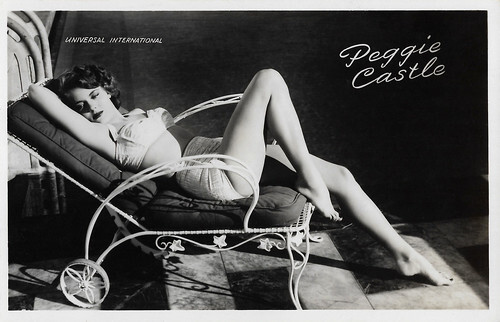
Dutch postcard by Takken, no. 461. Photo: Universal International.
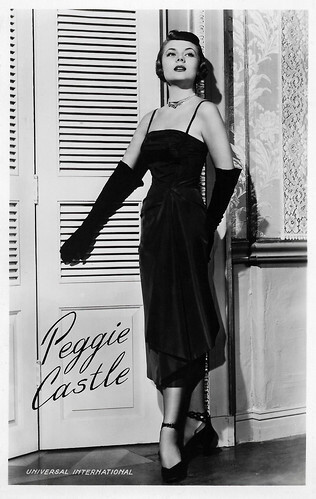
Dutch postcard by Takken / 't Sticht, no. 160. Photo: Universal International.
Miss Classy Chassis
Peggie (sometimes written as Peggy) Castle was born as Peggy Thomas Blair in Appalachia, Wise County, Virginia, in 1927. Her mother was Elizabeth Blair. Her father, Doyle H. Blair, was a director of an industrial relations firm. When the family moved to Hollywood, he was hired as a studio manager at Goldwyn Studios. He also worked as a business manager for Donald O'Connor.
Later, Peggie changed her surname Blair at the first studio in which she worked. She took lessons in drama when she was 8 years old. Castle graduated from Hollywood High School and attended Mills College for two years. Castle's first work as an actress came in the soap opera 'Today's Children'. Then a spot on Radio Theatre in 1947 brought her a screen test offer from 20th Century Fox.
According to Hollywood lore, Castle was discovered by a talent scout while eating a shrimp cocktail in the seafood bar of the Farmer's Market in Beverly Hills. She was signed to a seven-year contract with Universal-International and made her film debut credited as Peggy Call in When a Girl's Beautiful (Frank McDonald, 1947) starring Adele Jergens.
In 1949, she was named "Miss Cheesecake" by the Southern California Restaurant Association. Later that year, the Junior Chamber of Commerce named Castle "Miss Three Alarm" and she was voted "Miss Classy Chassis" by members of the United Automobile Workers Union from seven Western states. That year, she also had a part in the comedy Mr. Belvedere Goes to College (Elliott Nugent, 1949), starring Clifton Webb as prickly genius Lynn Belvedere who enrols in a major university with the intention of obtaining a four-year degree in only one year.
In 1950, she was signed by Universal-International on instigation by Universal star Audie Murphy, whom she was seeing at the time. Hal Erickson at AllMovie: "Peggie Castle seemed to have stepped out of the pages of Mickey Spillane, and in fact starred in two films based on Spillane's works: I, the Jury (Harry Essex, 1953) and The Long Wait (Victor Saville, 1954) opposite Anthony Quinn .
During the 1950s, Peggie appeared in such films as the drama Payment on Demand (Curtis Bernhardt, 1951) starring Bette Davis , the technicolour Swashbuckler The Prince Who Was a Thief (Rudolph Mate, 1951) starring Tony Curtis and Piper Laurie , the Red Scare drama Invasion U.S.A. (Alfred E. Green, 1952), the Film Noir 99 River Street (Phil Karlson, 1953). Peggie Castle often starred in Westerns, appearing in nearly a dozen between Wagons West (Ford Beebe, 1952) starring Rod Cameron, and Hell's Crossroads (Franklin Adreon, 1957). Her later films also include the Science Fiction film Beginning of the End (Bert I. Gordon, 1957) and Arrivederci Roma/Seven Hills of Rome (Roy Rowland, 1957) with tenor Mario Lanza and Marisa Allasio .
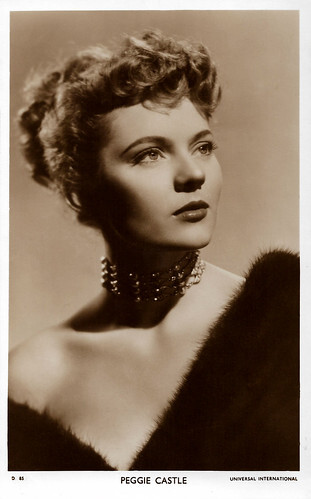
British postcard in the Picturegoer Series, London, no. D. 85. Photo: Universal International.
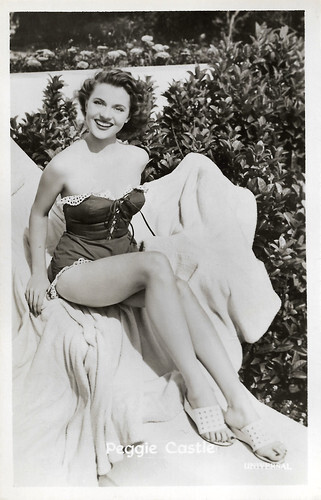
Vintage card. Photo: Universal.
The Case of the Negligent Nymph
In the late 1950s, Peggie Castle moved into television. She appeared in multiple guest roles on Fireside Theater, Cheyenne, 77 Sunset Strip, and The Restless Gun. In 1957 she appeared as Amy Gordon opposite Clint Walker on Cheyenne in the episode titled The Spanish Grant. In 1957 she played defendant Sally Fenner in the Perry Mason episode, The Case of the Negligent Nymph.
Also in 1957, she was a primary star on Gunsmoke, playing a forlorn Nita Tucker in the episode Chester’s Murder. From 1959 to 1962, she co-starred in the television Western series Lawman — her first continuing series. Her role as saloon owner Lily Merrill brought out a new dimension of Castle's talent. She stated, "For the first time in my life I'm a singer — that's the producer's opinion, not mine."
Her final on-screen role was a guest appearance in a 1966 episode of The Virginian. In 1958, Castle acted with Jesse White in a stage production of 'A Hole in the Head' at the Civic Playhouse in Los Angeles. In 1960, Castle and Peter Brown (who also was a regular in Lawman) travelled to rodeos, performing as a song-and-dance team. Castle stressed, "We're very careful not to sing any romantic songs," treating the act more like a brother-sister team. The duo's stops included St. Louis, Chicago, Detroit, Pittsburgh, and Albuquerque.
In 1960, she received a star on the Hollywood Walk of Fame. Castle was married four times. She married Revis T. Call, a 2nd Lieutenant in the Army in 1945, in Los Angeles. Following that marriage, she began using Peggy Call as her professional name. They divorced in 1950. She married Universal publicist Robert H. Raines in 1951 and they divorced in 1954.
In 1955, Castle married producer and director William McGarry. They had a daughter, Erin McGarry. Castle divorced McGarry in 1969. In 1971, she married Arthur Morganstern, her fourth husband. They remained married until Morganstern's death in 1973. Castle suffered from alcoholism. In 1969, she attempted suicide by taking an overdose of barbiturates and slashing her wrists. She was later committed to California's Camarillo State Hospital for her alcoholism, but she regressed after her release. In 1973, her third husband, William McGarry found her body on the couch of her Hollywood apartment. Her death was later determined to be caused by cirrhosis. She was only 45.
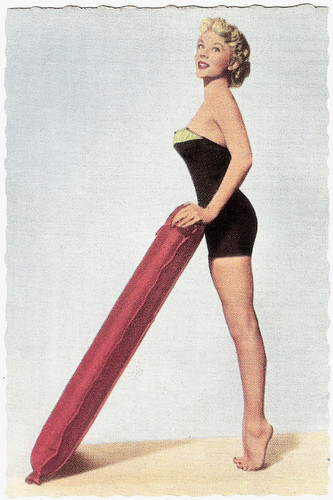
German collector's card by Druckerei Hanns Uhrig, Frankfurt a. M. Photo: Warner Bros. Pictures, Inc.
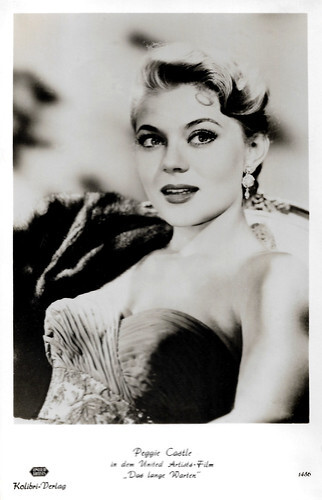
West-German card by Kolibri-Verlag, no. 1486. Photo: United Artists. Peggie Castle in The Long Wait (Victor Saville, 1954).
Sources: Hal Erickson (AllMovie), Wikipedia and .

Dutch postcard by Takken, no. 461. Photo: Universal International.

Dutch postcard by Takken / 't Sticht, no. 160. Photo: Universal International.
Miss Classy Chassis
Peggie (sometimes written as Peggy) Castle was born as Peggy Thomas Blair in Appalachia, Wise County, Virginia, in 1927. Her mother was Elizabeth Blair. Her father, Doyle H. Blair, was a director of an industrial relations firm. When the family moved to Hollywood, he was hired as a studio manager at Goldwyn Studios. He also worked as a business manager for Donald O'Connor.
Later, Peggie changed her surname Blair at the first studio in which she worked. She took lessons in drama when she was 8 years old. Castle graduated from Hollywood High School and attended Mills College for two years. Castle's first work as an actress came in the soap opera 'Today's Children'. Then a spot on Radio Theatre in 1947 brought her a screen test offer from 20th Century Fox.
According to Hollywood lore, Castle was discovered by a talent scout while eating a shrimp cocktail in the seafood bar of the Farmer's Market in Beverly Hills. She was signed to a seven-year contract with Universal-International and made her film debut credited as Peggy Call in When a Girl's Beautiful (Frank McDonald, 1947) starring Adele Jergens.
In 1949, she was named "Miss Cheesecake" by the Southern California Restaurant Association. Later that year, the Junior Chamber of Commerce named Castle "Miss Three Alarm" and she was voted "Miss Classy Chassis" by members of the United Automobile Workers Union from seven Western states. That year, she also had a part in the comedy Mr. Belvedere Goes to College (Elliott Nugent, 1949), starring Clifton Webb as prickly genius Lynn Belvedere who enrols in a major university with the intention of obtaining a four-year degree in only one year.
In 1950, she was signed by Universal-International on instigation by Universal star Audie Murphy, whom she was seeing at the time. Hal Erickson at AllMovie: "Peggie Castle seemed to have stepped out of the pages of Mickey Spillane, and in fact starred in two films based on Spillane's works: I, the Jury (Harry Essex, 1953) and The Long Wait (Victor Saville, 1954) opposite Anthony Quinn .
During the 1950s, Peggie appeared in such films as the drama Payment on Demand (Curtis Bernhardt, 1951) starring Bette Davis , the technicolour Swashbuckler The Prince Who Was a Thief (Rudolph Mate, 1951) starring Tony Curtis and Piper Laurie , the Red Scare drama Invasion U.S.A. (Alfred E. Green, 1952), the Film Noir 99 River Street (Phil Karlson, 1953). Peggie Castle often starred in Westerns, appearing in nearly a dozen between Wagons West (Ford Beebe, 1952) starring Rod Cameron, and Hell's Crossroads (Franklin Adreon, 1957). Her later films also include the Science Fiction film Beginning of the End (Bert I. Gordon, 1957) and Arrivederci Roma/Seven Hills of Rome (Roy Rowland, 1957) with tenor Mario Lanza and Marisa Allasio .

British postcard in the Picturegoer Series, London, no. D. 85. Photo: Universal International.

Vintage card. Photo: Universal.
The Case of the Negligent Nymph
In the late 1950s, Peggie Castle moved into television. She appeared in multiple guest roles on Fireside Theater, Cheyenne, 77 Sunset Strip, and The Restless Gun. In 1957 she appeared as Amy Gordon opposite Clint Walker on Cheyenne in the episode titled The Spanish Grant. In 1957 she played defendant Sally Fenner in the Perry Mason episode, The Case of the Negligent Nymph.
Also in 1957, she was a primary star on Gunsmoke, playing a forlorn Nita Tucker in the episode Chester’s Murder. From 1959 to 1962, she co-starred in the television Western series Lawman — her first continuing series. Her role as saloon owner Lily Merrill brought out a new dimension of Castle's talent. She stated, "For the first time in my life I'm a singer — that's the producer's opinion, not mine."
Her final on-screen role was a guest appearance in a 1966 episode of The Virginian. In 1958, Castle acted with Jesse White in a stage production of 'A Hole in the Head' at the Civic Playhouse in Los Angeles. In 1960, Castle and Peter Brown (who also was a regular in Lawman) travelled to rodeos, performing as a song-and-dance team. Castle stressed, "We're very careful not to sing any romantic songs," treating the act more like a brother-sister team. The duo's stops included St. Louis, Chicago, Detroit, Pittsburgh, and Albuquerque.
In 1960, she received a star on the Hollywood Walk of Fame. Castle was married four times. She married Revis T. Call, a 2nd Lieutenant in the Army in 1945, in Los Angeles. Following that marriage, she began using Peggy Call as her professional name. They divorced in 1950. She married Universal publicist Robert H. Raines in 1951 and they divorced in 1954.
In 1955, Castle married producer and director William McGarry. They had a daughter, Erin McGarry. Castle divorced McGarry in 1969. In 1971, she married Arthur Morganstern, her fourth husband. They remained married until Morganstern's death in 1973. Castle suffered from alcoholism. In 1969, she attempted suicide by taking an overdose of barbiturates and slashing her wrists. She was later committed to California's Camarillo State Hospital for her alcoholism, but she regressed after her release. In 1973, her third husband, William McGarry found her body on the couch of her Hollywood apartment. Her death was later determined to be caused by cirrhosis. She was only 45.

German collector's card by Druckerei Hanns Uhrig, Frankfurt a. M. Photo: Warner Bros. Pictures, Inc.

West-German card by Kolibri-Verlag, no. 1486. Photo: United Artists. Peggie Castle in The Long Wait (Victor Saville, 1954).
Sources: Hal Erickson (AllMovie), Wikipedia and .
Published on August 07, 2022 22:00
August 6, 2022
Photo by Larry Shaw
Last week, EFSP did a post on famed photographer Sam Shaw. His son, Larry Shaw (1937-2007), followed in his father's footsteps as a special photographer for the cinema. One of his first assignments was the film Paris Blues (1960) and later, he would often work in France but also covered the films of John Cassavetes.
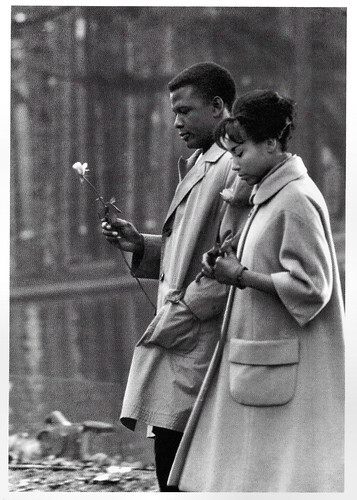
Swiss-German-British postcard by New Productions, Baulmes and Stroud, and Filmwelt Berlin, Bakede, no. 56576, 1994. Photo: Larry Shaw. Sidney Poitier and Diahann Carroll in Paris Blues (Martin Ritt, 1961). Caprion: Bois de Boulogne, Paris, 1961.
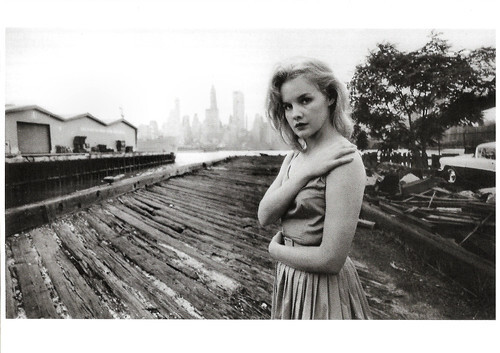
Swiss-British postcard by News Productions, Baulmes / Stroud, no. 56737, 1996. Photo: Larry Shaw. Caption: Carroll Baker , New York City, 1960.
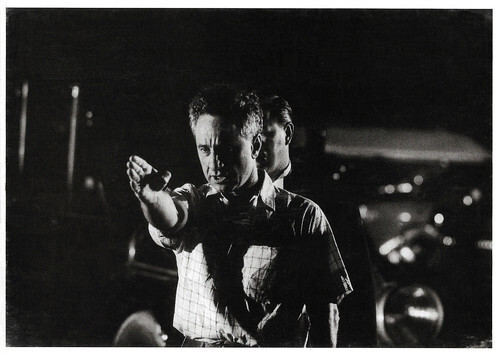
Swiss-British postcard by News Productions, Baulmes and Stroud, no. 56760, 1996. Photo: Larry Shaw. Director Elia Kazan on the set of Splendor in the Grass (1960) in NYC, 1960.
Paris Blues
Larry Shaw was born in 1937 in New York City. As a teenager, Larry was an assistant to his father, Sam Shaw, and was an apprentice to several of Sam’s photographer colleagues. Larry worked as an assistant to Martin Muncasci, Louis Fauer and Bert Stern. Larry learned the elements of formal studio photography and classical lighting from these masters and the elements of photo reportage and special cinema coverage from his father.
His first independent assignment was a reportage on Strip Tease and Burlesque in New Orleans, 1958 for the premiere issue of Huntington Hartford’s Show Magazine. This was followed by a second story in Show Magazine on the Irish playwright Brendon Behan. In 1960, Larry was assigned the job of special photographer for advertising and publicity for the film Paris Blues (Martin Ritt, 1961) with Paul Newman , Joanne Woodward and Sidney Poitier . His Paris Blues photographs were published in such magazines as Life, Ebony, Paris Match and other journals throughout Europe.
With the success of his first cinema reportage coverage, Larry followed in the footsteps of his father as a special photographer for motion pictures and had publications and photo essays for films such as Phaedra (Jules Dassin, 1962), The Comancheros (Michael Curtiz, 1961) starring John Wayne , Walk on the Wild Side (Edward Dmytryk, 1962) and Cleopatra (Joseph L. Mankiewicz, 1963) starring Elizabeth Taylor . In France he covered Le Caporal épinglé/The Elusive Corporal (Jean Renoir, 1962) and Les parapluies de Cherbourg/The Umbrellas of Cherbourg (Jacques Démy, 1964).
Larry obtained special coverage for the films of John Cassavetes, including Shadows (1958), Faces (1968), Husbands (1970), Gloria (1980) and Love Streams (1984). His other film assignments include The Visit (Bernhard Wicki, 1964) with Ingrid Bergman , Candy (Christian Marquand, 1968), Harlow (Gordon Douglas, 1964)), What's New Pussycat (Cliove Donner, 1965), The Dirty Dozen (Robert Aldrich, 1967) and Casino Royale (Val Guest, Ken Hughes, John Huston, 1967). His photo essays have appeared in Life, Look, Cosmopolitan, Stern, Bunte, Marie Claire, Vogue, Tempo, Cahier du Cinema, The New York Times, London Sunday Times, Playboy and many other magazines.
Larry Shaw did special coverage on the sisters Catherine Deneuve and Francoise Dorléac , on the first English supermodel Twiggy, and on Geraldine Chaplin , Mohammad Ali, Woody Allen, Louis Armstrong , Duke Ellington, Marcello Mastroianni , Carol Baker , Marianne Faithfull , Horst Buchholz , Cher , Juliette Gréco , Romy Schneider , Ursula Andress and Claudia Cardinale for publications in magazines and books.
Before Sam Shaw died, he filed a lawsuit against his son claiming that Larry stole thousands of photographs, including the most famous and lucrative, the Marilyn Monroe photos. Sam Shaw died before the lawsuit could be concluded; but it was settled posthumously by his daughters, Meta Shaw Stevens and Edith Shaw Marcus. The family struck a settlement in 2002 under which Shaw Family Archives was created to take ownership of the 500,000 photos in Sam Shaw’s possession as well as 20,000 photos Larry Shaw had. Larry Shaw died in 2007 at the age of 70. He was the father of Jakob Shaw.
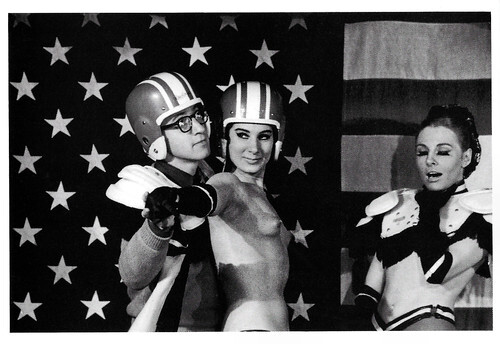
Swiss-German-British postcard by News Productions, Baulmes / Filmwelt Berlin, Bakede / News Productions, Stroud, no. 56570 Photo: Larry Shaw. Caption: Woody Allen at the Crazy Horse, Paris, 1965.
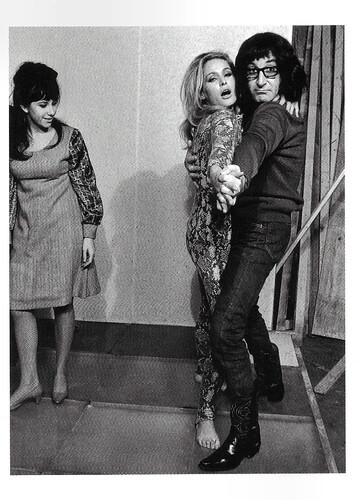
Swiss postcard by CVB Publishers / News Productions, no. 56961. Photo: Larry Shaw. Peter Sellers and Ursula Andress at the set of What's New Pussycat (Clive Donner, 1965).
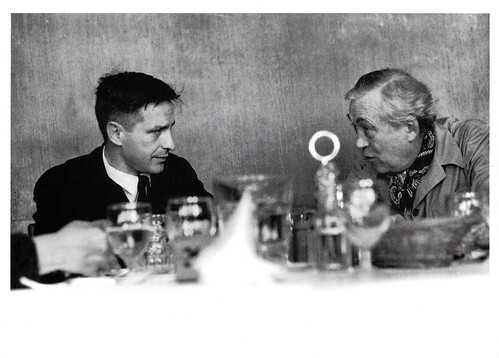
Swiss-British-German postcard by News Productions, Baulmes and Stroud / Filmwelt Berlin, Bakede, no. 56569, 1994. Photo: Larry Shaw. Caption: John Cassavetes and John Huston, Pinewood Studios, England, 1967.
Sources: Art-Loft, Allmand Law and .

Swiss-German-British postcard by New Productions, Baulmes and Stroud, and Filmwelt Berlin, Bakede, no. 56576, 1994. Photo: Larry Shaw. Sidney Poitier and Diahann Carroll in Paris Blues (Martin Ritt, 1961). Caprion: Bois de Boulogne, Paris, 1961.

Swiss-British postcard by News Productions, Baulmes / Stroud, no. 56737, 1996. Photo: Larry Shaw. Caption: Carroll Baker , New York City, 1960.

Swiss-British postcard by News Productions, Baulmes and Stroud, no. 56760, 1996. Photo: Larry Shaw. Director Elia Kazan on the set of Splendor in the Grass (1960) in NYC, 1960.
Paris Blues
Larry Shaw was born in 1937 in New York City. As a teenager, Larry was an assistant to his father, Sam Shaw, and was an apprentice to several of Sam’s photographer colleagues. Larry worked as an assistant to Martin Muncasci, Louis Fauer and Bert Stern. Larry learned the elements of formal studio photography and classical lighting from these masters and the elements of photo reportage and special cinema coverage from his father.
His first independent assignment was a reportage on Strip Tease and Burlesque in New Orleans, 1958 for the premiere issue of Huntington Hartford’s Show Magazine. This was followed by a second story in Show Magazine on the Irish playwright Brendon Behan. In 1960, Larry was assigned the job of special photographer for advertising and publicity for the film Paris Blues (Martin Ritt, 1961) with Paul Newman , Joanne Woodward and Sidney Poitier . His Paris Blues photographs were published in such magazines as Life, Ebony, Paris Match and other journals throughout Europe.
With the success of his first cinema reportage coverage, Larry followed in the footsteps of his father as a special photographer for motion pictures and had publications and photo essays for films such as Phaedra (Jules Dassin, 1962), The Comancheros (Michael Curtiz, 1961) starring John Wayne , Walk on the Wild Side (Edward Dmytryk, 1962) and Cleopatra (Joseph L. Mankiewicz, 1963) starring Elizabeth Taylor . In France he covered Le Caporal épinglé/The Elusive Corporal (Jean Renoir, 1962) and Les parapluies de Cherbourg/The Umbrellas of Cherbourg (Jacques Démy, 1964).
Larry obtained special coverage for the films of John Cassavetes, including Shadows (1958), Faces (1968), Husbands (1970), Gloria (1980) and Love Streams (1984). His other film assignments include The Visit (Bernhard Wicki, 1964) with Ingrid Bergman , Candy (Christian Marquand, 1968), Harlow (Gordon Douglas, 1964)), What's New Pussycat (Cliove Donner, 1965), The Dirty Dozen (Robert Aldrich, 1967) and Casino Royale (Val Guest, Ken Hughes, John Huston, 1967). His photo essays have appeared in Life, Look, Cosmopolitan, Stern, Bunte, Marie Claire, Vogue, Tempo, Cahier du Cinema, The New York Times, London Sunday Times, Playboy and many other magazines.
Larry Shaw did special coverage on the sisters Catherine Deneuve and Francoise Dorléac , on the first English supermodel Twiggy, and on Geraldine Chaplin , Mohammad Ali, Woody Allen, Louis Armstrong , Duke Ellington, Marcello Mastroianni , Carol Baker , Marianne Faithfull , Horst Buchholz , Cher , Juliette Gréco , Romy Schneider , Ursula Andress and Claudia Cardinale for publications in magazines and books.
Before Sam Shaw died, he filed a lawsuit against his son claiming that Larry stole thousands of photographs, including the most famous and lucrative, the Marilyn Monroe photos. Sam Shaw died before the lawsuit could be concluded; but it was settled posthumously by his daughters, Meta Shaw Stevens and Edith Shaw Marcus. The family struck a settlement in 2002 under which Shaw Family Archives was created to take ownership of the 500,000 photos in Sam Shaw’s possession as well as 20,000 photos Larry Shaw had. Larry Shaw died in 2007 at the age of 70. He was the father of Jakob Shaw.

Swiss-German-British postcard by News Productions, Baulmes / Filmwelt Berlin, Bakede / News Productions, Stroud, no. 56570 Photo: Larry Shaw. Caption: Woody Allen at the Crazy Horse, Paris, 1965.

Swiss postcard by CVB Publishers / News Productions, no. 56961. Photo: Larry Shaw. Peter Sellers and Ursula Andress at the set of What's New Pussycat (Clive Donner, 1965).

Swiss-British-German postcard by News Productions, Baulmes and Stroud / Filmwelt Berlin, Bakede, no. 56569, 1994. Photo: Larry Shaw. Caption: John Cassavetes and John Huston, Pinewood Studios, England, 1967.
Sources: Art-Loft, Allmand Law and .
Published on August 06, 2022 22:00
August 5, 2022
L'uomo più allegro di Vienna (1925)
Maria Corda, Ruggero Ruggeri and Victor Varconi star in the Italian silent film L'uomo più allegro di Vienna/The Most Cheerful Man in Vienna (1925). Amleto Palermi directed and produced the film with his Palermi Films. G.B. Falci and A. Traldi both produced a series of attractive postcards of the film.
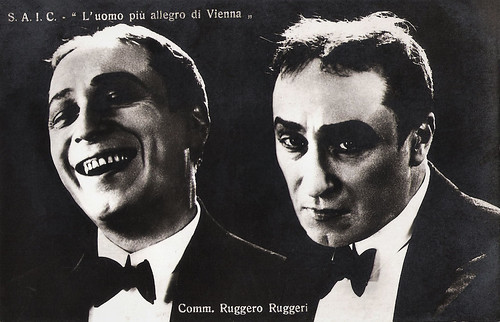
Italian postcard by Ed. A. Traldi, Milano. Photo: S.A.I.C. Ruggero Ruggeri in L'uomo più allegro di Vienna/The Most Cheerful Man in Vienna (Amleto Palermi, 1925).
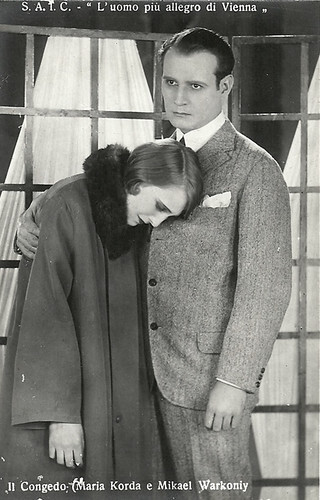
Italian postcard by Ed. A. Traldi, Milano. photo: S.A.I.C. / Palermi Films. Maria Corda and Victor Varconi in L'uomo più allegro di Vienna (Amleto Palermi, 1925). Caption: Il Congedo/The Goodbye.
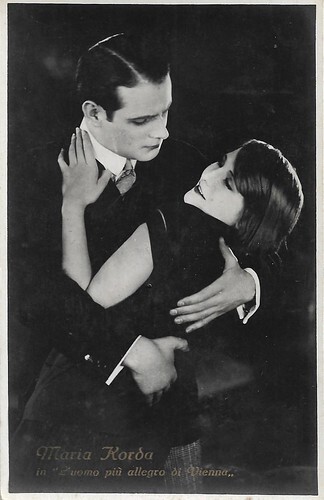
Italian postcard by G.B. Falci, Milano, no. 345. Photo: La Fotominio / Fotolux / Palermi Films. Maria Corda and Victor Varconi in L'uomo più allegro di Vienna/The Most Cheerful Man in Vienna (Amleto Palermi, 1925).
Quite moralistic but also modern
The plot of L'uomo più allegro di Vienna/The Most Cheerful Man in Vienna (Amleto Palermi, 1925) is quite moralistic but also modern. Katy, a young girl ( Maria Corda ) is easily attracted to a fancy life by a gigolo, William (Victor Varconi). Her father Max Bluck (Ruggero Ruggeri), a happy-go-lucky leader of a jazz band, energetically manages to subtract her from danger, even if all the relatives think he is a good-for-nothing.
Hungarian Maria Corda (1898-1975) was an immensely popular star of the silent cinema of Austria and Germany. The pretty, blonde actress was a queen of the popular epic spectacles of the 1920s, which were often directed by her husband, Alexander Korda.
Ruggero Ruggeri (1871-1953) was one the most important Italian stage actors of the first half of the twentieth century, who often performed the plays by Pirandello. He did perform in films too, both in silent and sound films. Nowadays, he is best remembered as the voice of Jesus in the Don Camillo films.
Handsome Victor Varconi (1891–1976) was a highly successful matinee idol of the Hungarian-Austrian and German silent cinema in the 1910s and early 1920s. Later he was the first Hungarian actor to become a Hollywood star until the sound film completely altered the course of his career.
In addition to Corda, Ruggeri and Varconi, Gianna Terribili Gonzales played Katy's mother, Loulou. Cinematography was by Vittore Armenise, while art direction was by Nino Macarones and Vittorio Cafiero.
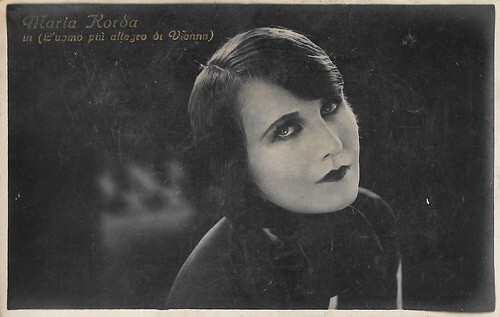
Italian postcard by G.B. Falci, Milano, no. 341. Photo: La Fotominio / Fotolux / Palermi Films. Maria Corda in L'uomo più allegro di Vienna/The Most Cheerful Man in Vienna (Amleto Palermi, 1925).
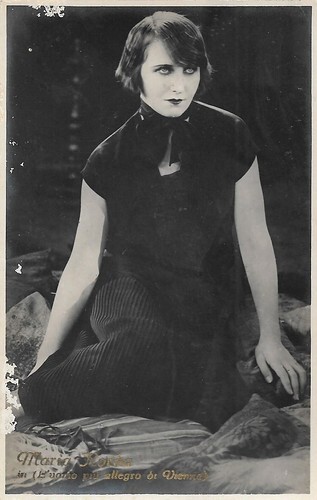
Italian postcard by G.B. Falci, Milano, no. 343. Photo: La Fotominio / Fotolux / Palermi Films. Maria Corda in L'uomo più allegro di Vienna/The Most Cheerful Man in Vienna (Amleto Palermi, 1925).
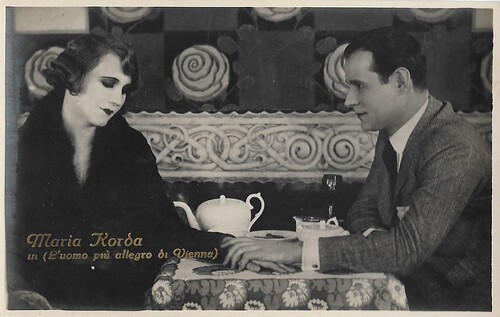
Italian postcard by G.B. Falci, Milano, no. 345. Photo: La Fotominio / Fotolux / Palermi Films. Maria Corda and Victor Varconi in L'uomo più allegro di Vienna/The Most Cheerful Man in Vienna (Amleto Palermi, 1925).
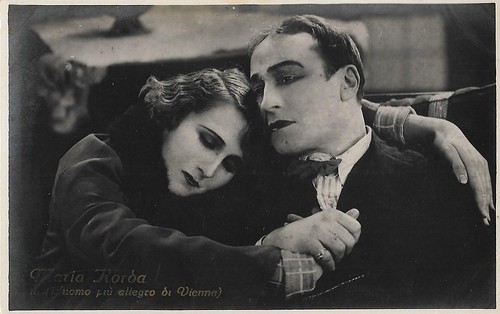
Italian postcard by G.B. Falci, Milano, no. 349. Photo: La Fotominio / Fotolux / Palermi Films. Maria Corda and Ruggero Ruggeri in L'uomo più allegro di Vienna/The Most Cheerful Man in Vienna (Amleto Palermi, 1925).
Set in the louche dens of Vienna with its brutish visitors
L'uomo più allegro di Vienna/The Most Cheerful Man in Vienna (Amleto Palermi, 1925) was produced by Palermi's company A. P. Films (Almeto Palermi Films), while S.A.I.C. distributed it. On 25 November 1925, the film had its premiere in Rome.
At the time, the Milanese journal La rassegna del teatro e del cinematografo wrote that the plot seemed like a modernised Rigoletto, as a very moral tale about a father who in vain tries to prevent his daughter from dishonour, and also commented that the story was not entirely innocent, set in the louche dens of Vienna with its brutish visitors. The journal concluded the film was like a true restaurant dish: good meat but with an indigestible sauce.
In addition, the Roman source Il Tevere wrote that the plot may have seemed sentimental and old hat, but Ruggero Ruggeri gave a modern, innovative performance to it, giving his character a life of its own, while Maria Corda was given ample space to excel side by side with him.
A print of L'uomo più allegro di Vienna/The Most Cheerful Man in Vienna was restored by the Cineteca del Friuli, Gemona (Italy), in collaboration with the Hungarian National Film Archive in Budapest.
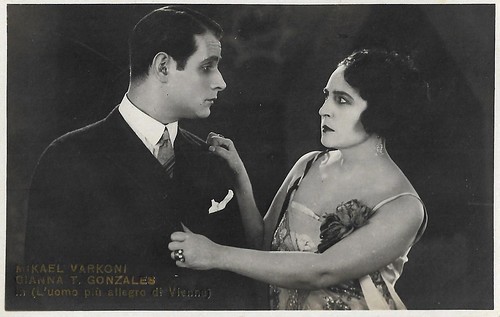
Italian postcard by G.B. Falci, Milano, no. 402. Photo: La Fotominio. Gianna Terribili Gonzales as Loulou and Victor Varconi as William in L'uomo più allegro di Vienna/The Most Cheerful Man in Vienna (Amleto Palermi, 1925).
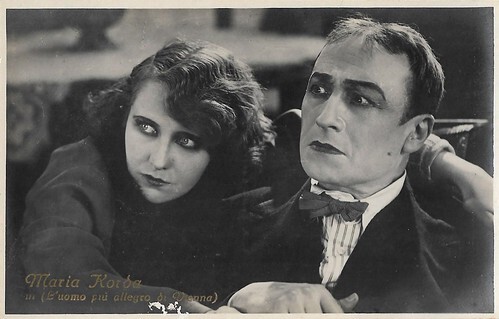
Italian postcard by G.B. Falci, Milano, no. 350. Photo: La Fotominio / Fotolux / Palermi Films. Maria Corda and Ruggero Ruggeri in L'uomo più allegro di Vienna/The Most Cheerful Man in Vienna (Amleto Palermi, 1925).
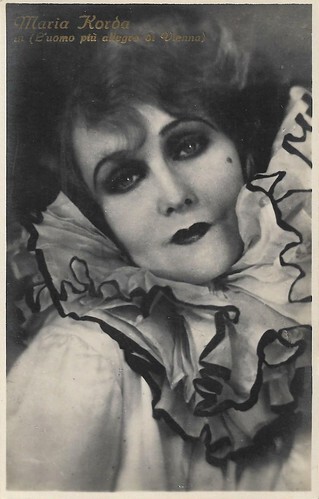
Italian postcard by G.B. Falci, Milano, no. 352. Photo: La Fotominio / Fotolux / Palermi Films. Maria Corda in L'uomo più allegro di Vienna/The Most Cheerful Man in Vienna (Amleto Palermi, 1925).
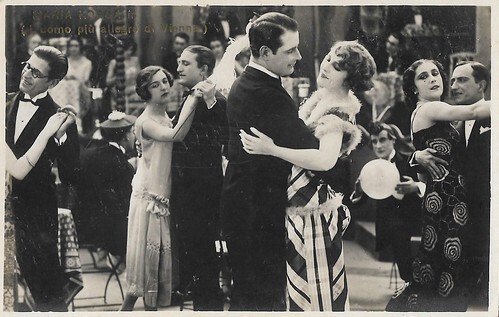
Italian postcard by G.B. Falci, Milano, no. 363. Photo: La Fotominio / Fotolux / Palermi Films. Maria Corda and Victor Varconi in L'uomo più allegro di Vienna/The Most Cheerful Man in Vienna (Amleto Palermi, 1925).
Sources: Vittorio Martinelli (Il cinema muto italiano, 1923-1931 - Italian), Cineteca del Friuli, and IMDb.

Italian postcard by Ed. A. Traldi, Milano. Photo: S.A.I.C. Ruggero Ruggeri in L'uomo più allegro di Vienna/The Most Cheerful Man in Vienna (Amleto Palermi, 1925).

Italian postcard by Ed. A. Traldi, Milano. photo: S.A.I.C. / Palermi Films. Maria Corda and Victor Varconi in L'uomo più allegro di Vienna (Amleto Palermi, 1925). Caption: Il Congedo/The Goodbye.

Italian postcard by G.B. Falci, Milano, no. 345. Photo: La Fotominio / Fotolux / Palermi Films. Maria Corda and Victor Varconi in L'uomo più allegro di Vienna/The Most Cheerful Man in Vienna (Amleto Palermi, 1925).
Quite moralistic but also modern
The plot of L'uomo più allegro di Vienna/The Most Cheerful Man in Vienna (Amleto Palermi, 1925) is quite moralistic but also modern. Katy, a young girl ( Maria Corda ) is easily attracted to a fancy life by a gigolo, William (Victor Varconi). Her father Max Bluck (Ruggero Ruggeri), a happy-go-lucky leader of a jazz band, energetically manages to subtract her from danger, even if all the relatives think he is a good-for-nothing.
Hungarian Maria Corda (1898-1975) was an immensely popular star of the silent cinema of Austria and Germany. The pretty, blonde actress was a queen of the popular epic spectacles of the 1920s, which were often directed by her husband, Alexander Korda.
Ruggero Ruggeri (1871-1953) was one the most important Italian stage actors of the first half of the twentieth century, who often performed the plays by Pirandello. He did perform in films too, both in silent and sound films. Nowadays, he is best remembered as the voice of Jesus in the Don Camillo films.
Handsome Victor Varconi (1891–1976) was a highly successful matinee idol of the Hungarian-Austrian and German silent cinema in the 1910s and early 1920s. Later he was the first Hungarian actor to become a Hollywood star until the sound film completely altered the course of his career.
In addition to Corda, Ruggeri and Varconi, Gianna Terribili Gonzales played Katy's mother, Loulou. Cinematography was by Vittore Armenise, while art direction was by Nino Macarones and Vittorio Cafiero.

Italian postcard by G.B. Falci, Milano, no. 341. Photo: La Fotominio / Fotolux / Palermi Films. Maria Corda in L'uomo più allegro di Vienna/The Most Cheerful Man in Vienna (Amleto Palermi, 1925).

Italian postcard by G.B. Falci, Milano, no. 343. Photo: La Fotominio / Fotolux / Palermi Films. Maria Corda in L'uomo più allegro di Vienna/The Most Cheerful Man in Vienna (Amleto Palermi, 1925).

Italian postcard by G.B. Falci, Milano, no. 345. Photo: La Fotominio / Fotolux / Palermi Films. Maria Corda and Victor Varconi in L'uomo più allegro di Vienna/The Most Cheerful Man in Vienna (Amleto Palermi, 1925).

Italian postcard by G.B. Falci, Milano, no. 349. Photo: La Fotominio / Fotolux / Palermi Films. Maria Corda and Ruggero Ruggeri in L'uomo più allegro di Vienna/The Most Cheerful Man in Vienna (Amleto Palermi, 1925).
Set in the louche dens of Vienna with its brutish visitors
L'uomo più allegro di Vienna/The Most Cheerful Man in Vienna (Amleto Palermi, 1925) was produced by Palermi's company A. P. Films (Almeto Palermi Films), while S.A.I.C. distributed it. On 25 November 1925, the film had its premiere in Rome.
At the time, the Milanese journal La rassegna del teatro e del cinematografo wrote that the plot seemed like a modernised Rigoletto, as a very moral tale about a father who in vain tries to prevent his daughter from dishonour, and also commented that the story was not entirely innocent, set in the louche dens of Vienna with its brutish visitors. The journal concluded the film was like a true restaurant dish: good meat but with an indigestible sauce.
In addition, the Roman source Il Tevere wrote that the plot may have seemed sentimental and old hat, but Ruggero Ruggeri gave a modern, innovative performance to it, giving his character a life of its own, while Maria Corda was given ample space to excel side by side with him.
A print of L'uomo più allegro di Vienna/The Most Cheerful Man in Vienna was restored by the Cineteca del Friuli, Gemona (Italy), in collaboration with the Hungarian National Film Archive in Budapest.

Italian postcard by G.B. Falci, Milano, no. 402. Photo: La Fotominio. Gianna Terribili Gonzales as Loulou and Victor Varconi as William in L'uomo più allegro di Vienna/The Most Cheerful Man in Vienna (Amleto Palermi, 1925).

Italian postcard by G.B. Falci, Milano, no. 350. Photo: La Fotominio / Fotolux / Palermi Films. Maria Corda and Ruggero Ruggeri in L'uomo più allegro di Vienna/The Most Cheerful Man in Vienna (Amleto Palermi, 1925).

Italian postcard by G.B. Falci, Milano, no. 352. Photo: La Fotominio / Fotolux / Palermi Films. Maria Corda in L'uomo più allegro di Vienna/The Most Cheerful Man in Vienna (Amleto Palermi, 1925).

Italian postcard by G.B. Falci, Milano, no. 363. Photo: La Fotominio / Fotolux / Palermi Films. Maria Corda and Victor Varconi in L'uomo più allegro di Vienna/The Most Cheerful Man in Vienna (Amleto Palermi, 1925).
Sources: Vittorio Martinelli (Il cinema muto italiano, 1923-1931 - Italian), Cineteca del Friuli, and IMDb.
Published on August 05, 2022 22:00
Paul van Yperen's Blog
- Paul van Yperen's profile
- 13 followers
Paul van Yperen isn't a Goodreads Author
(yet),
but they
do have a blog,
so here are some recent posts imported from
their feed.



